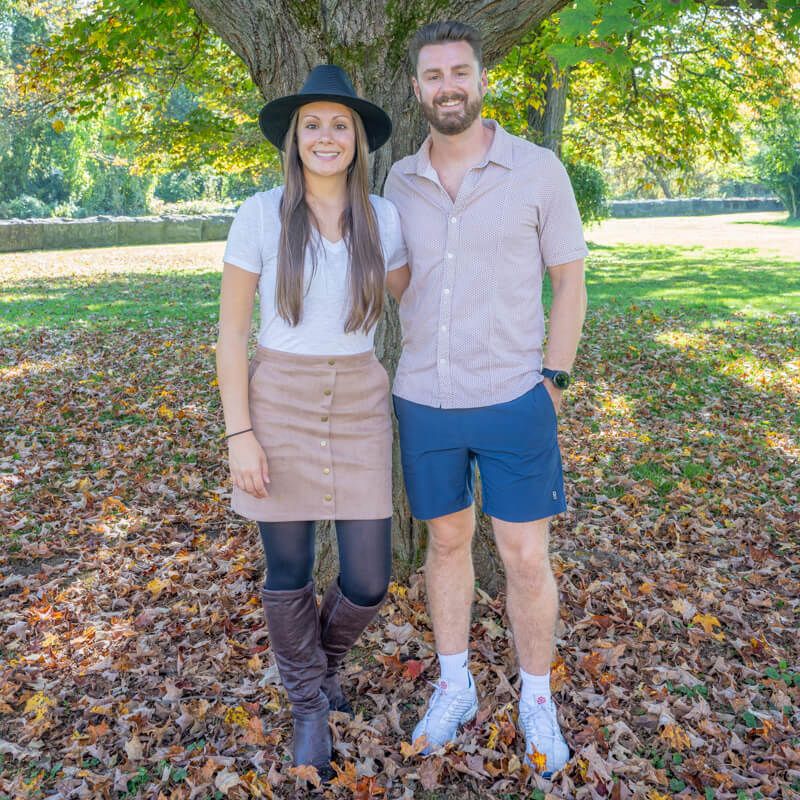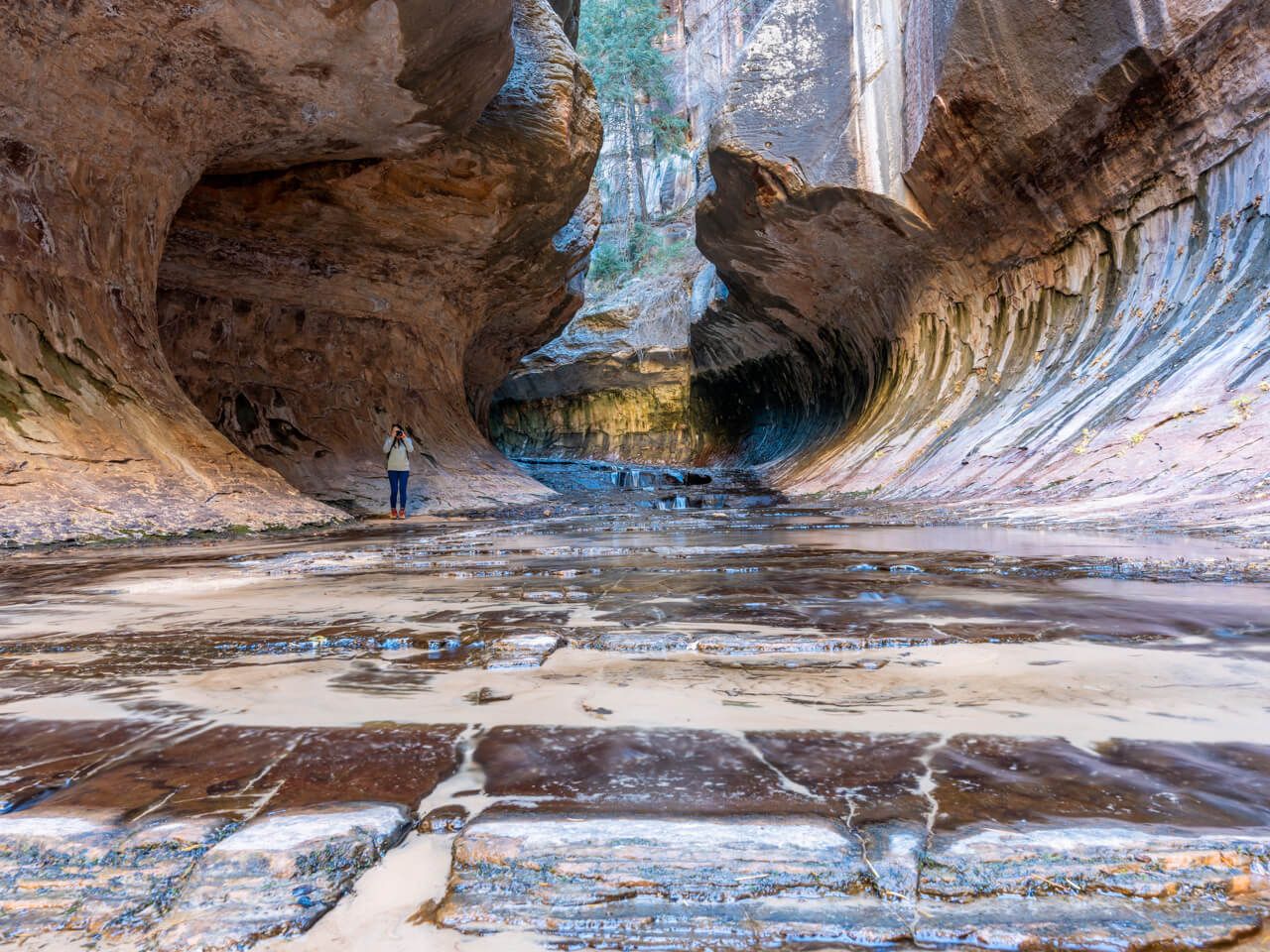Zion National Park has some of the most popular adventure hiking trails in the US, including Angels Landing, The Narrows and The Subway. But there are many more excellent hikes for the whole family to enjoy in Kolob Canyons, Kolob Terrace, East Rim and Zion Canyon.
In this guide, we’re going to walk you through the 20 best hikes in Zion National Park ordered from easy to hard and based entirely on our own experiences.
Our Zion Hiking Experience
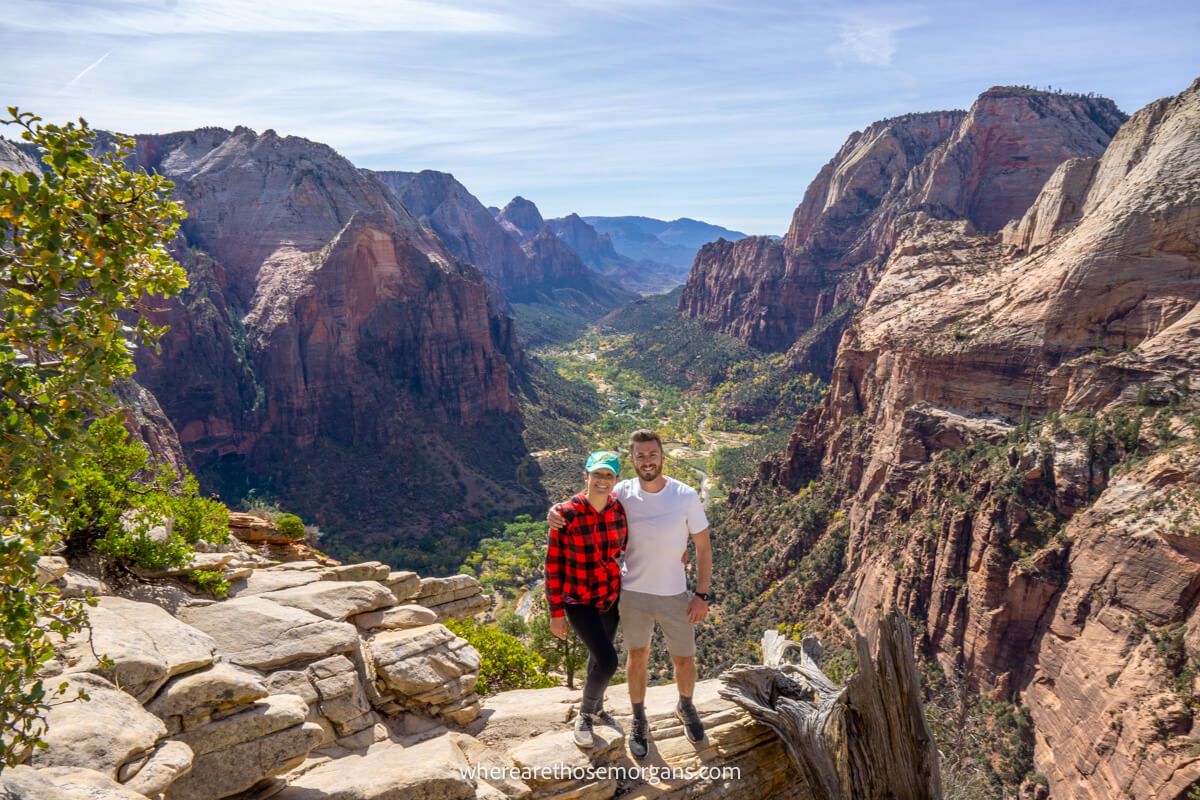
We’ve hiked almost all of the popular trails in Zion over the course of 6 full days in the national park. Our first trip was for 3 days in October 2019 when Zion was packed full of hikers, and our second visit was for 3 more days in December 2021 when Zion was surprisingly crowd free. Read more about us.
It’s a close call, but we’d say The Narrows beats Angels Landing and The Subway as our favorite adventure hike in Zion because it’s just so unique and exciting. Outside of the big 3, Zion Canyon Overlook and Timber Creek Overlook are easy hikes leading to stunning viewpoints.
Zion National Park Hiking Regions
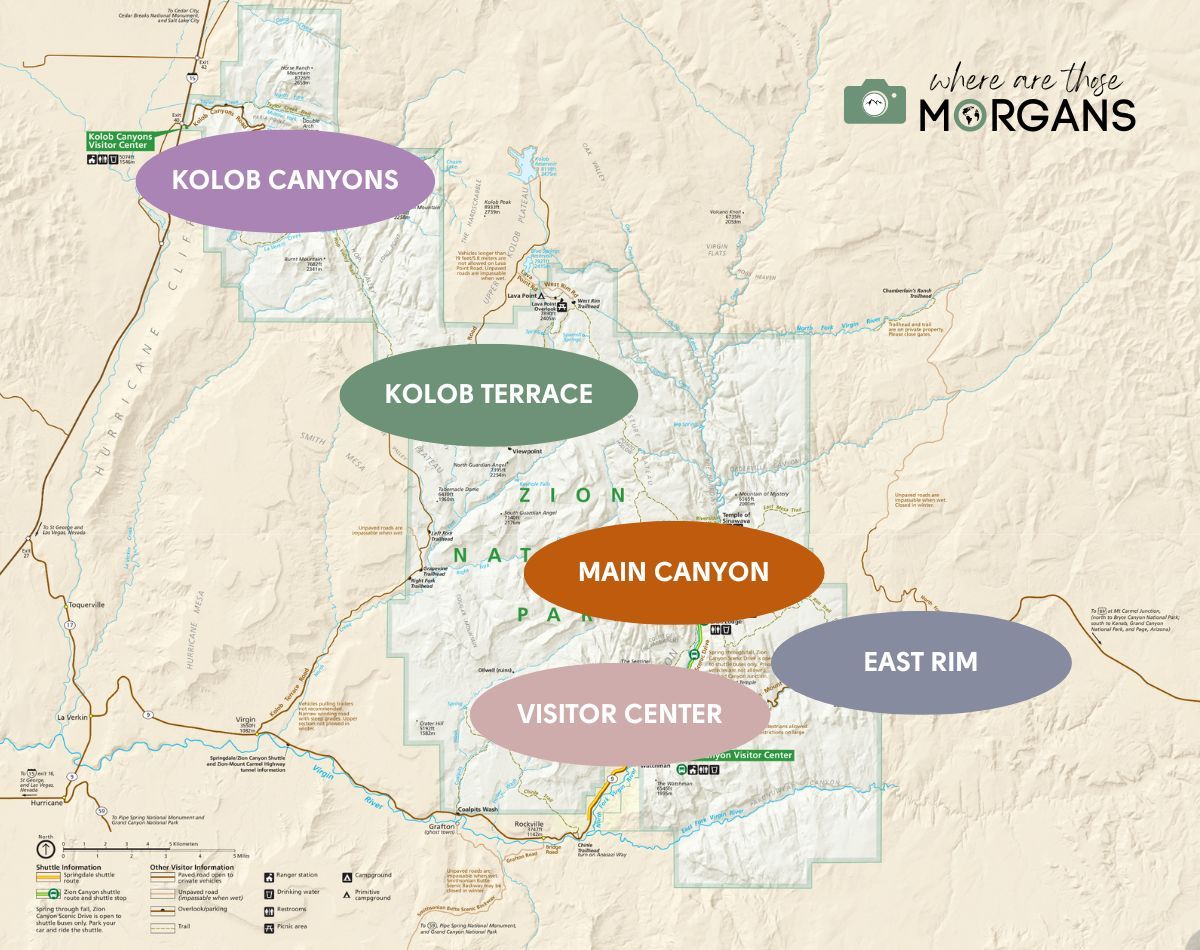
There are 5 major hiking regions in Zion National Park:
- 1. Zion Main Canyon
- 2. East Rim
- 3. Zion Visitor Center
- 4. Kolob Terrace
- 5. Kolob Canyon
Let’s take a quick look at each region:
Hiking Tip: Hikes in Zion’s main canyon, visitor center and east rim regions are easy to access as a group. But you’ll need to drive 30 minutes to Kolob Terrace and 45 minutes to Kolob Canyons from Springdale.
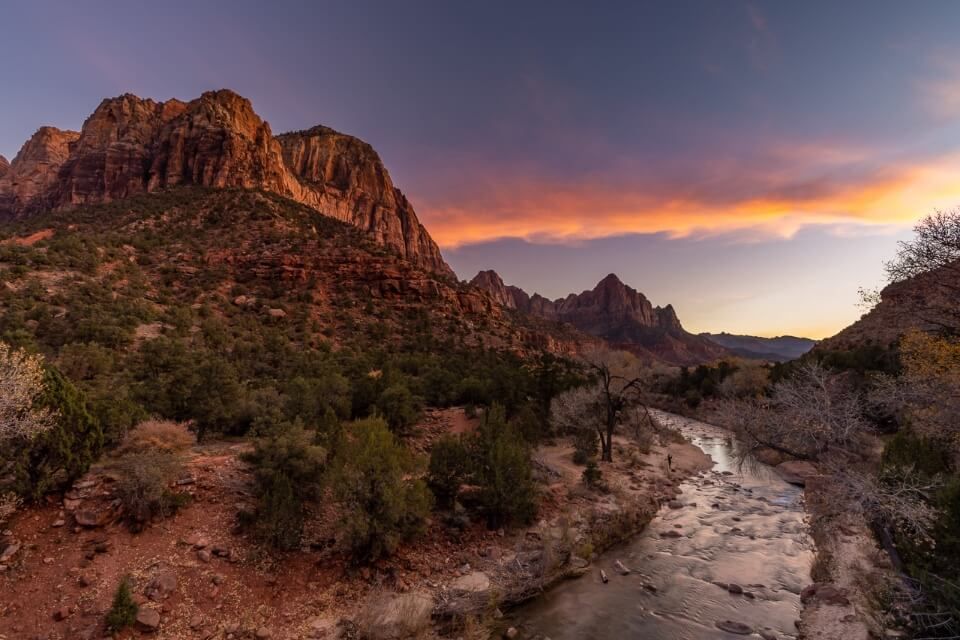
1. Zion Main Canyon
Zion’s Main Canyon is by far the busiest region in the national park. It’s where you’ll find two of the best hikes in the US in Angels Landing and The Narrows, as well as Zion Lodge and at least 90% of visitors at the park. If you’re planning a first visit to Zion, you should prioritize hikes in the Main Canyon.
2. East Rim
East Rim can be reached by driving through the Zion-Mt Carmel Tunnel after gaining elevation from the Main Canyon. You’ll find the family friendly Zion Canyon Overlook Trail and one or two off the beaten path hikes on the East Rim.
3. Zion Visitor Center
Zion’s main visitor center is located in Springdale, which is where the vast majority of hotels near Zion can be found. At the visitor center you can learn about the park and take shuttles into the Main Canyon. This is where you can pick up hikes like The Watchman Trail and Pa’rus Trail.
4. Kolob Terrace
Kolob Terrace is a much quieter region of Zion. It’s where you’ll find lesser known trails and wilderness hikes if you’re interested in backpacking. The main reason you would visit Kolob Terrace is to day hike The Subway bottom up from Left Fork Trailhead.
5. Kolob Canyons
Kolob Canyon is where you hike in Zion if you want to escape the crowds. Hikes in Kolob Canyons include Timber Creek Overlook, Taylor Creek Trail, La Verkin Creek and a hidden hike you won’t find on any map. The trails aren’t as scenic as the Main Canyon but at least you’ll be able to move!
Further Reading: The 4 best hikes in Kolob Canyons
Zion Hiking Trails Map
Click or touch the map of Zion below to activate.
Zoom in and out, move around the map and familiarize yourself with the trailhead locations of each hike you’ll find in this guide.
Map key:
- Orange – Main Canyon
- Blue – East Rim
- Pink – Visitor Center
- Green – Kolob Terrace
- Purple – Kolob Canyons
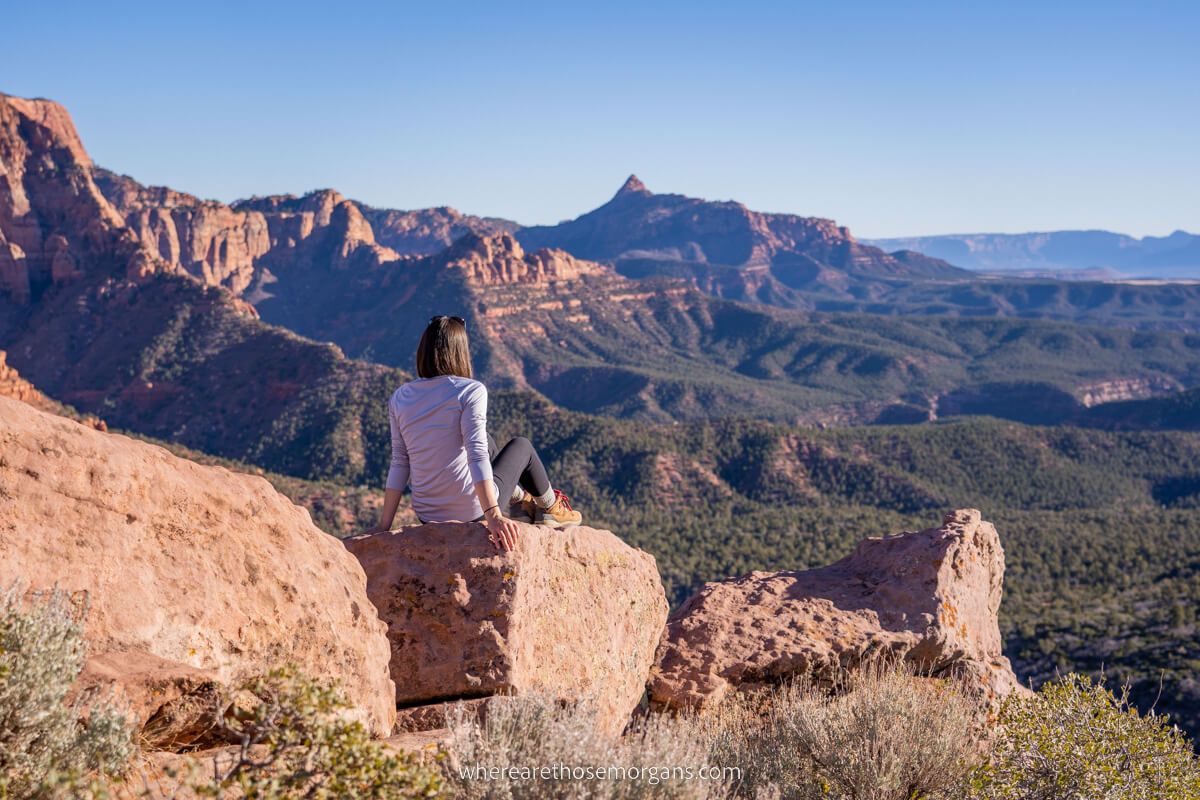
Best Easy Hikes In Zion National Park
Easy hikes in Zion give you the chance to appreciate some of rugged canyons and dramatic vistas with very little effort. Our favorites are Zion Canyon Overlook Trail and Timber Creek Overlook Trail because they lead to postcard-perfect viewpoints.
Below you’ll find the easiest hikes in Zion National Park that are perfect for beginners and the whole family.
1. Kayenta Trail
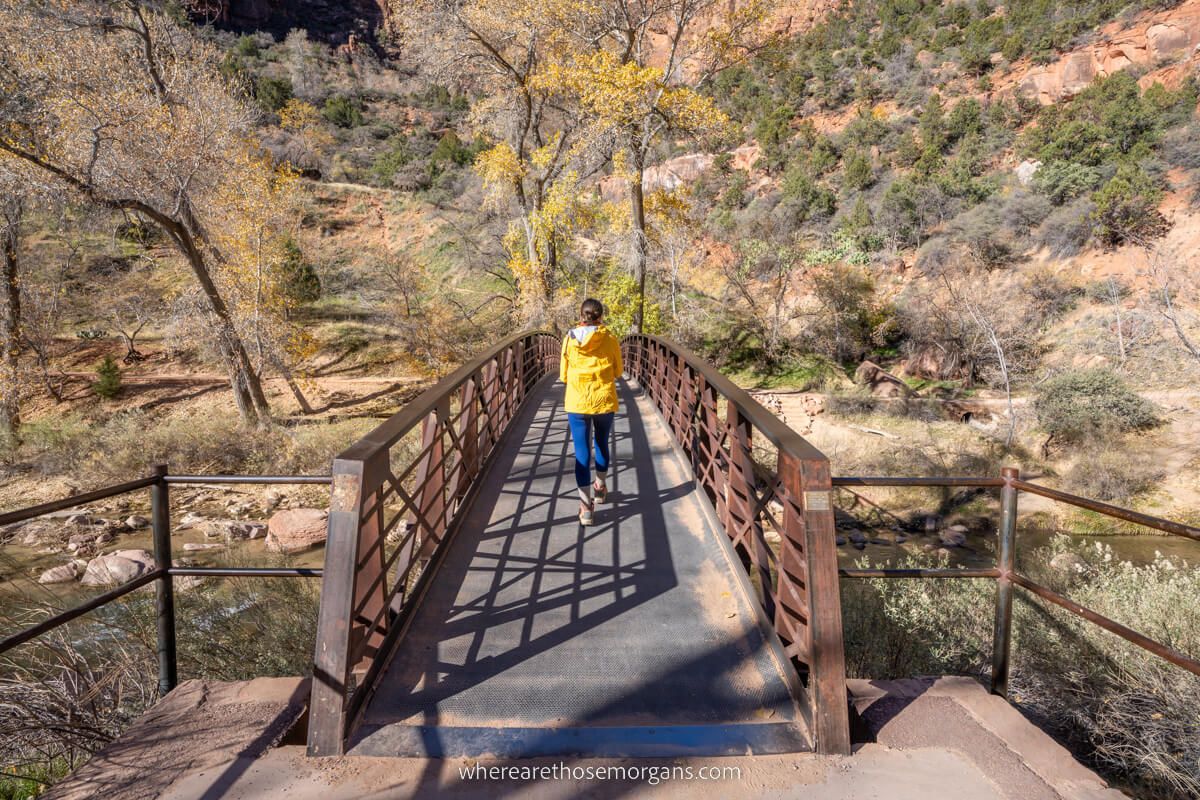
- Region: Main Canyon
- Trailhead: Grotto Trailhead (shuttle stop #6)
- Trail Difficulty: Easy
- Trail Distance: 2 miles roundtrip
- Type of Trail: Out and back
- Elevation Gain: 150 ft
- Recent Comments: AllTrails
Kayenta Trail is a flat and easy interconnecting trail running alongside the Virgin River. It’s a scenic hike for the whole family to enjoy, and it also serves as the main trail for hikers who want to combine Emerald Pools with Angels Landing.
2. Pa’rus Trail
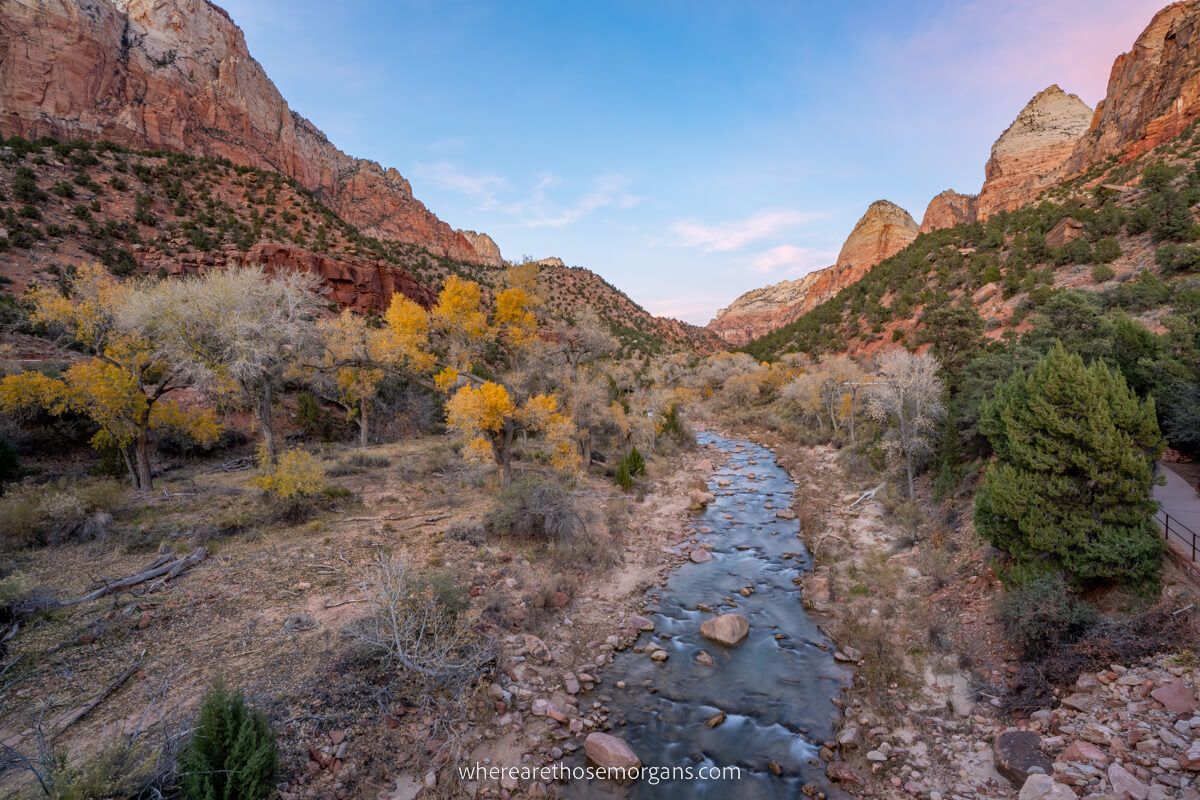
- Region: Visitor Center
- Trailhead: Zion Visitor Center
- Trail Difficulty: Easy
- Trail Distance: 3.5 miles roundtrip
- Type of Trail: Out and back
- Elevation Gain: 50 ft
- Recent Comments: All Trails
Pa’rus Trail is easy, flat and paved which makes it accessible for all visitors to Zion. The trail follows a scenic section of the Virgin River between Zion’s main visitor center and Canyon Junction Bridge. Pa’rus Trail is the only dog friendly hike in Zion, and there’s an unmissbale photo spot on the bridge.
Further Reading: How to hike Pa’rus Trail in Zion
3. Riverside Walk
- Region: Main Canyon
- Trailhead: Temple of Sinawava (shuttle stop #9)
- Trail Difficulty: Easy
- Trail Distance: 2.2 miles roundtrip
- Type of Trail: Out and back
- Elevation Gain: 60 ft
- Recent Comments: All Trails
Riverside Walk is a very easy and flat paved trail connecting the Temple of Sinawava with the beginning of The Narrows. It’s a great way for beginners to see what all the fuss is about with The Narrows without getting wet. You must hike Riverside Walk before and after day hiking The Narrows bottom up.
4. Grotto Trail
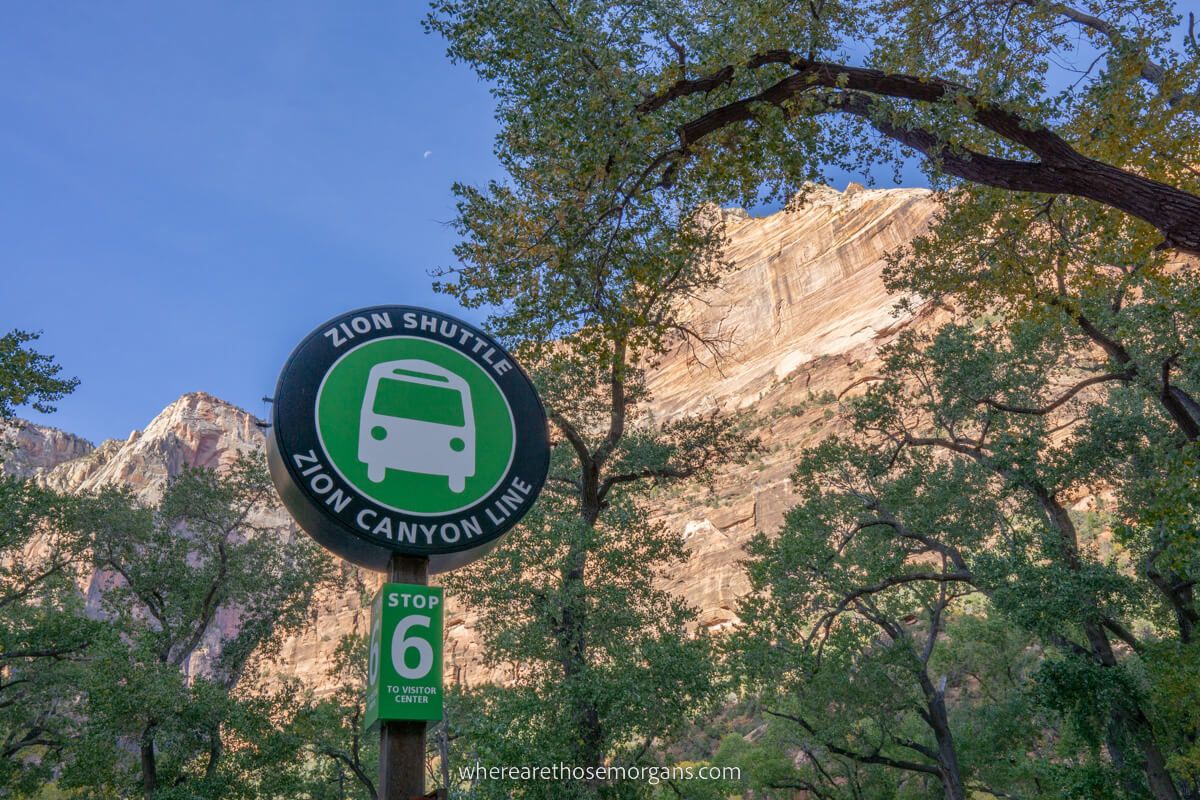
- Region: Main Canyon
- Trailhead: Zion Lodge
- Trail Difficulty: Easy
- Trail Distance: 1 mile roundtrip
- Type of Trail: Out and back
- Elevation Gain: 40 ft
- Recent Comments: All Trails
Grotto Trail is another easy connecting hike that you’ll use if you decide to stay at Zion Lodge. It connects Zion Lodge with Kayenta Trail and West Rim Trail which eventually leads to Angels Landing. Walking Grotto Trail is perfect for blowing off the cobwebs after eating breakfast at the lodge.
5. Weeping Rock Trail
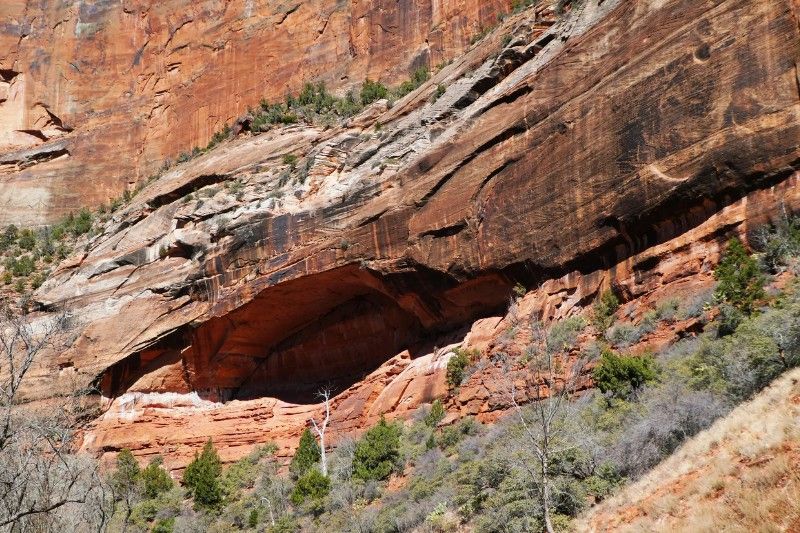
- Region: Main Canyon
- Trailhead: Shuttle stop #7
- Trail Difficulty: Easy
- Trail Distance: 0.5 miles roundtrip
- Type of Trail: Out and back
- Elevation Gain: 40 ft
- Recent Comments: All Trails
Weeping Rock is one of the easiest hikes in Zion and it leads to a concave formation with a waterfall plunging overhead, similar to Lower Emerald Pool. This is a fantastic family friendly trail with amazing down canyon views and one of very few waterfalls inside the main canyon, so don’t miss it.
6. Canyon Overlook Trail
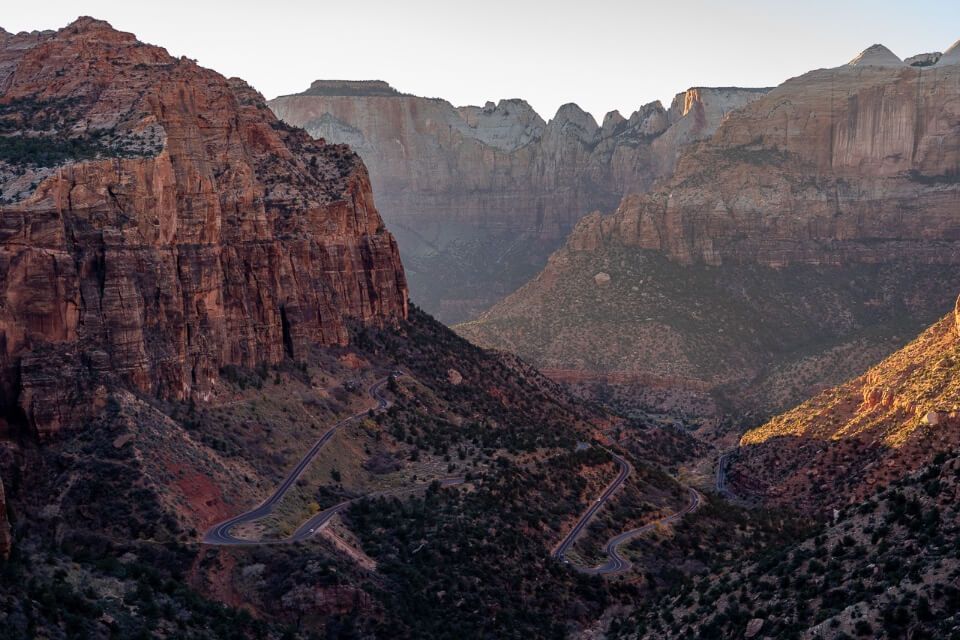
- Region: East Rim
- Trailhead: Zion-Mt Carmel Tunnel East
- Trail Difficulty: Easy
- Trail Distance: 1 mile roundtrip
- Type of Trail: Out and back
- Elevation Gain: 170 ft
- Recent Comments: All Trails
Canyon Overlook Trail is hands down the best easy hike in Zion National Park. It should be on every first time visitors Zion hiking itinerary because it’s a fun trail and it leads to spectacular views at Pine Creek Canyon Overlook. We love watching the sunset at the summit but sunrise would also be stunning.
Further Reading: How to hike Zion Canyon Overlook Trail
7. Timber Creek Overlook Trail
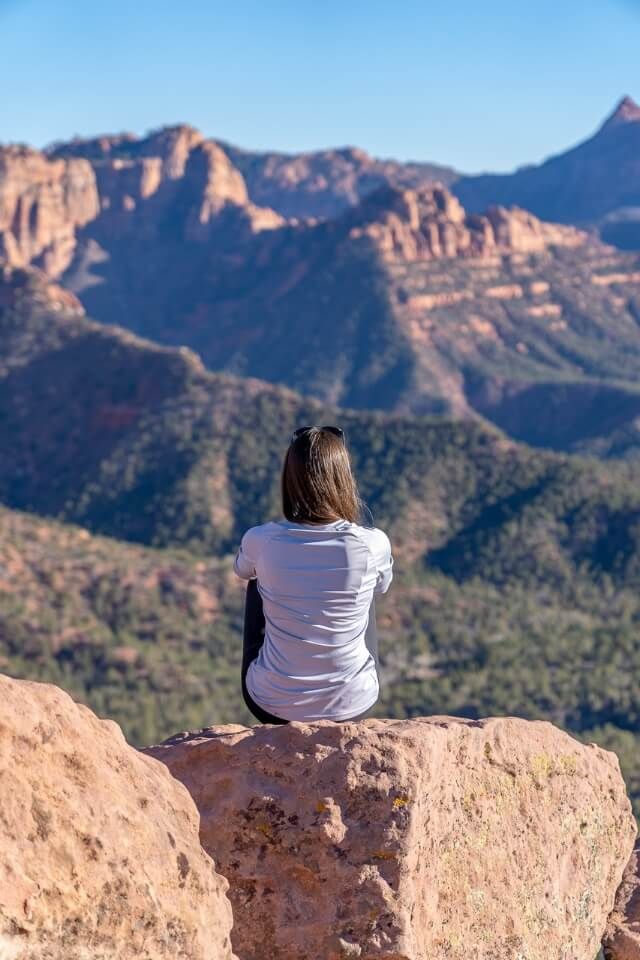
- Region: Kolob Canyons
- Trailhead: End of E Kolob Canyon Rd
- Trail Difficulty: Easy
- Trail Distance: 1 mile roundtrip
- Type of Trail: Out and back
- Elevation Gain: 100 ft
- Recent Comments: All Trails
Timber Creek Overlook Trail is short, easy and perfect for the whole family. For very little effort, your reward is far reaching views over canyon floors filled with trees and towering red rocks bursting out from Kolob Canyons and Kolob Terrace. This is one you shouldn’t miss if you go to Kolob Canyons.
Further Reading: How to hike Timber Creek Overlook Trail in Zion
Best Moderate Hikes In Zion National Park
Hikes at Zion become more fun and interesting when you step up the difficulty from easy to moderately difficult. By introducing elevation gain you’ll be able to access quieter viewpoints. Our favorites include Emerald Pools Trail, The Watchman Trail and East Mesa Trail.
Below you’ll find the best moderately difficult day hikes in Zion for first time visitors to the park.
8. Emerald Pools Trail
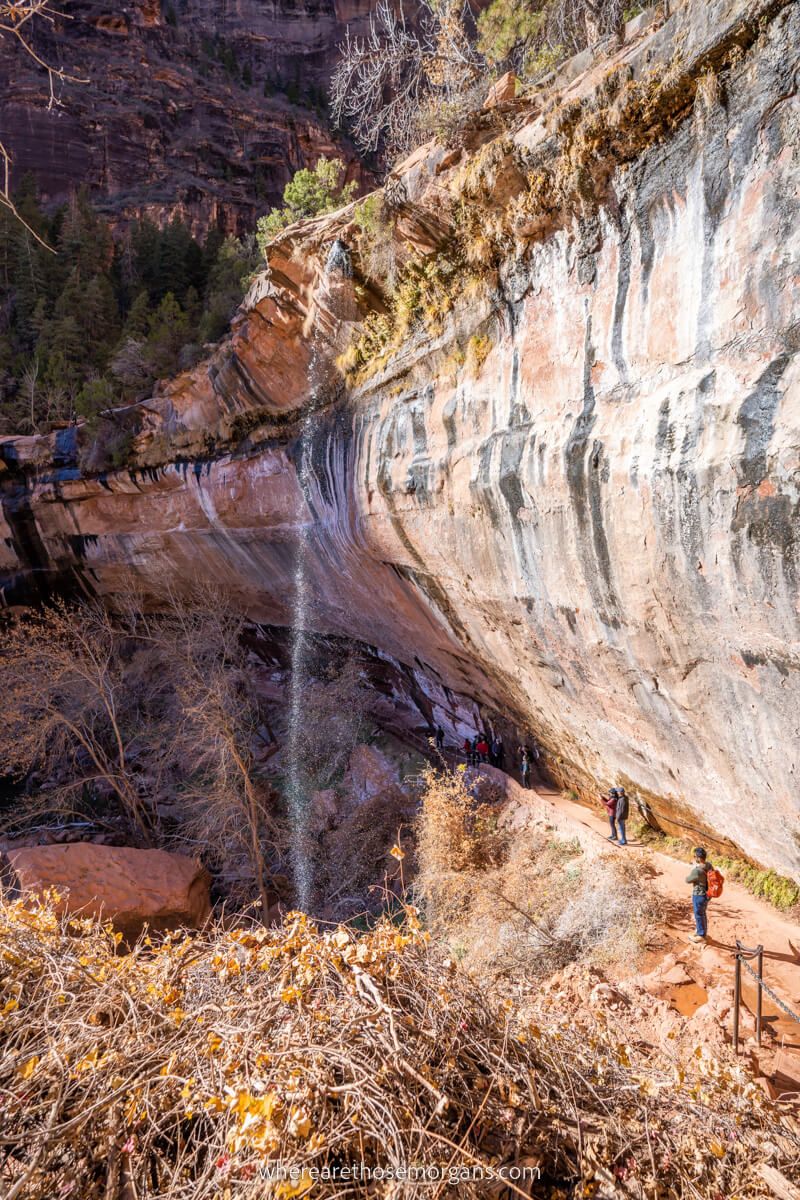
- Region: Main Canyon
- Trailhead: Zion Lodge (shuttle stop #5)
- Trail Difficulty: Moderate
- Trail Distance: 3.2 miles roundtrip
- Type of Trail: Out and back or loop
- Elevation Gain: 400 ft
- Recent Comments: All Trails
Emerald Pools Trail is among the very best family hikes in Zion National Park. Your teens will love this hike with three shallow pools, two waterfalls and an adventurous feel without being too dangerous like Angels Landing. The waterfalls are better in spring and early summer but it’s a popular trail year round.
Further Reading: How to hike Emerald Pools Trail in Zion
9. Sand Bench Trail
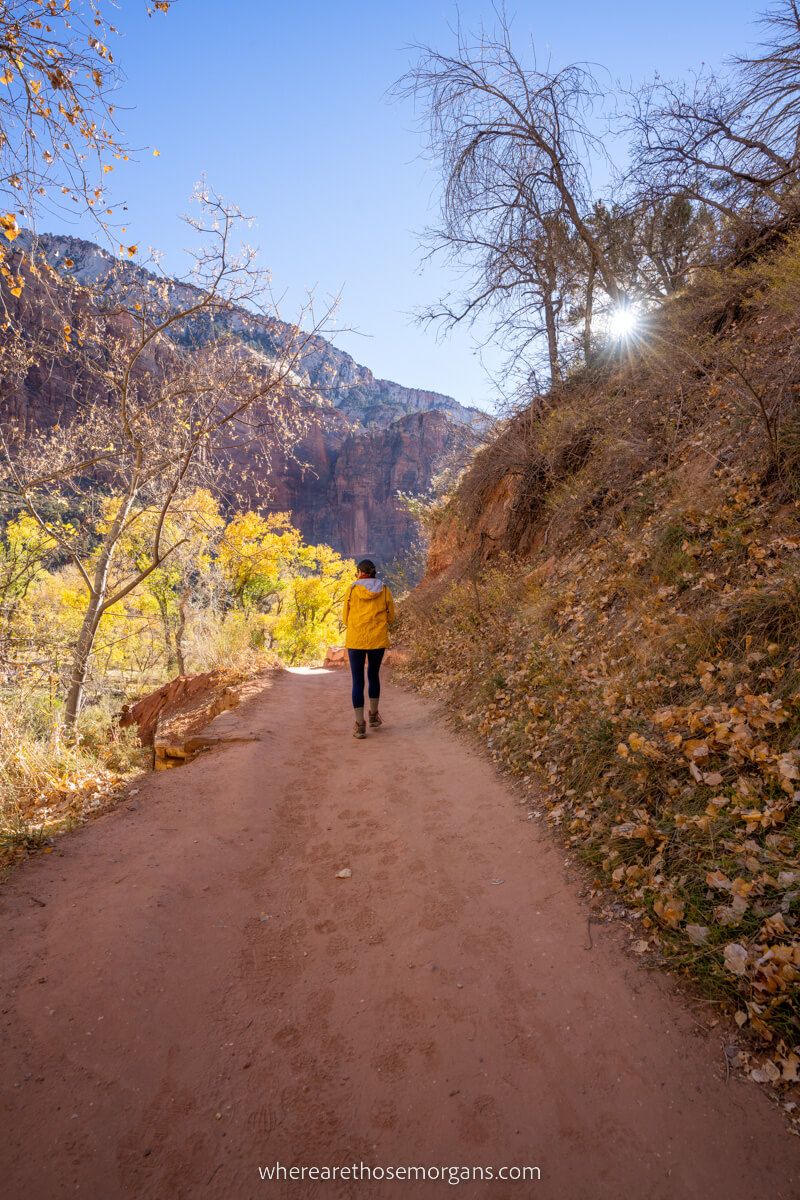
- Region: Main Canyon
- Trailhead: Court of the Patriarchs (shuttle stop #4)
- Trail Difficulty: Moderate
- Trail Distance: 5 miles roundtrip
- Type of Trail: Out and back with loop
- Elevation Gain: 450 ft
- Recent Comments: All Trails
Sand Bench Trail is one of those Zion hikes you’re either going to love or hate. It’s hard to walk on the soft sand and you’ll be sharing with horses in peak season. But it’s much quieter than other hikes in the main canyon and it has unique views. Sand Bench is great if you’re a return visitor or want a challenge.
10. Scout Lookout Trail
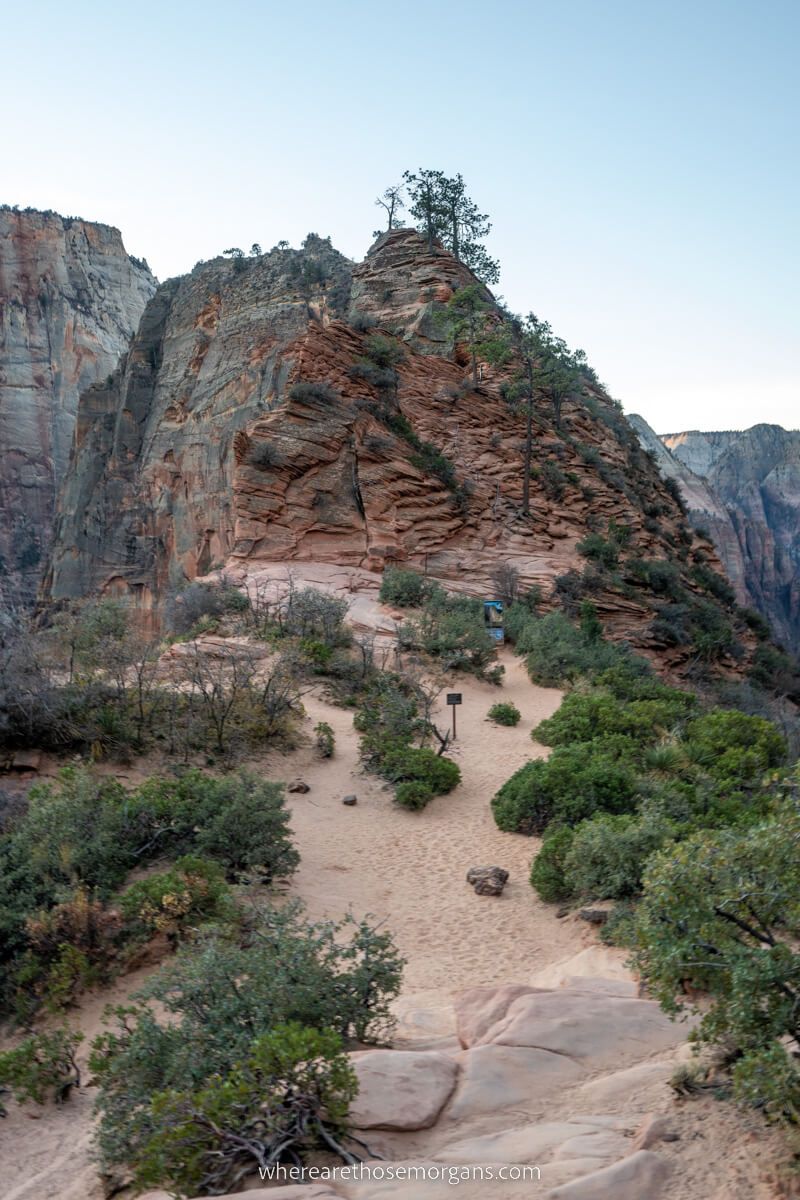
- Region: Main Canyon
- Trailhead: The Grotto (shuttle stop #6)
- Trail Difficulty: Moderate
- Trail Distance: 3.6 miles roundtrip
- Type of Trail: Out and back
- Elevation Gain: 1,100 ft
- Recent Comments: All Trails
Scout Lookout is a sandy summit used as a staging area before climbing to Angels Landing. A lot of hikers only go as far as Scout Lookout and wait while other group members go for Angels Landing, which is understandable! The steep trail to Scout Lookout is a thigh burner and it has great views.
Need help planning your trip to Zion?
Our popular Zion travel guidebook helps you with planning every aspect of your visit, including the unmissable hikes, where to eat and stay, itinerary ideas and map!
View Zion Guidebook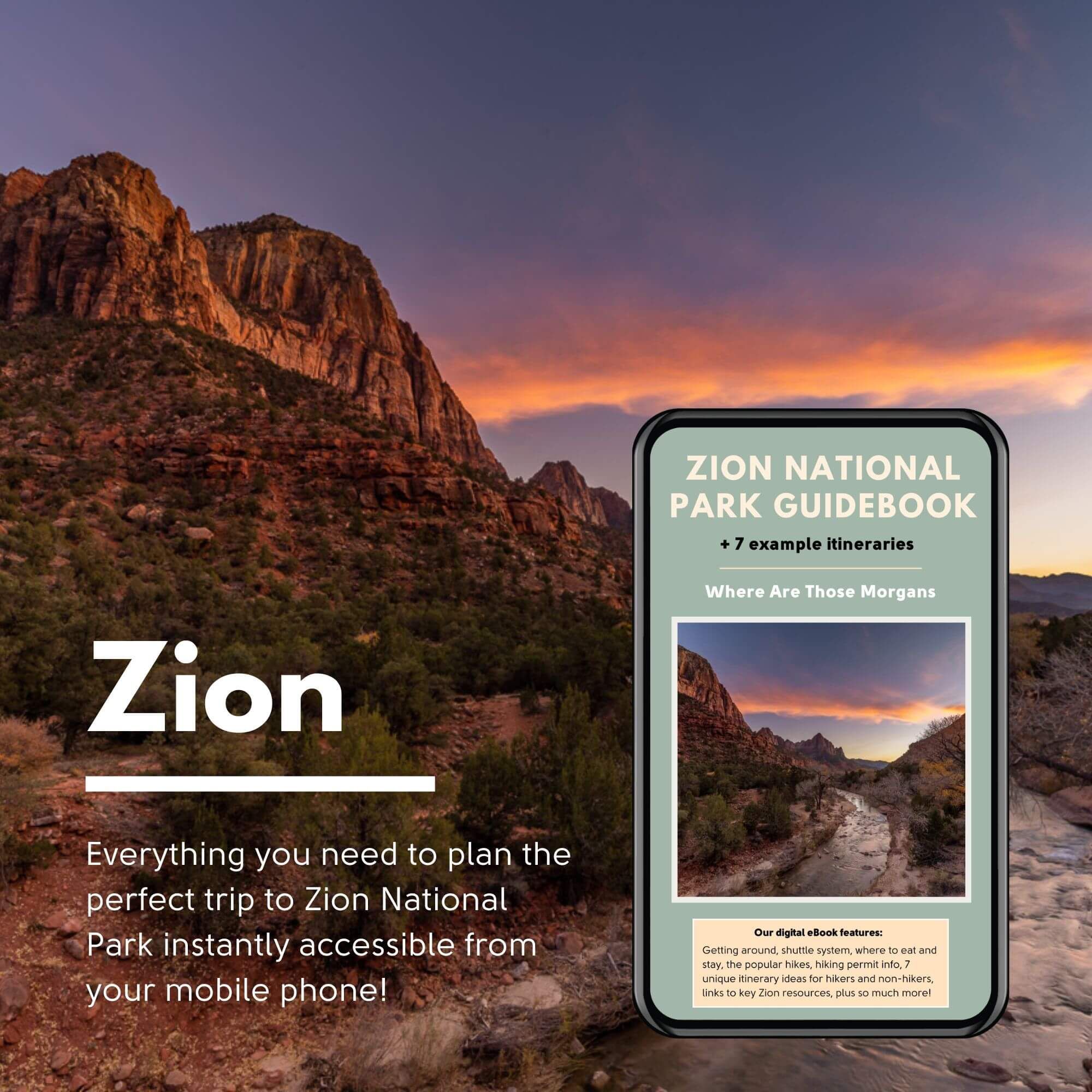
11. The Watchman Trail
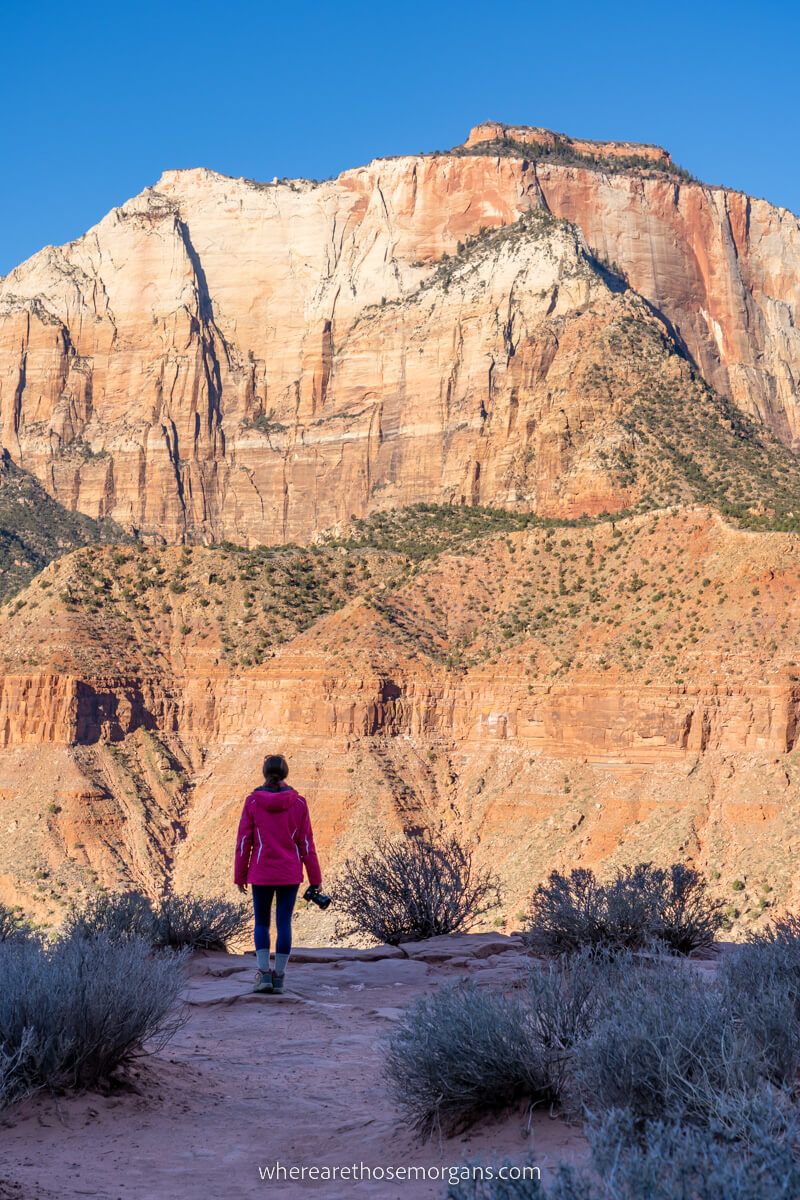
- Region: Visitor Center
- Trailhead: Zion Visitor Center
- Trail Difficulty: Moderate
- Trail Distance: 3.3 miles roundtrip
- Type of Trail: Out and back
- Elevation Gain: 370 ft
- Recent Comments: All Trails
The Watchman Trail is a hugely popular Zion hike beginning at the main visitor center. The trail itself isn’t anything special, but its small summit loop provides superb views over southern Zion and Springdale. We hiked to The Watchman summit for sunrise and had it all to ourselves.
Further Reading: How to hike The Watchman Trail in Zion
12. East Mesa Trail
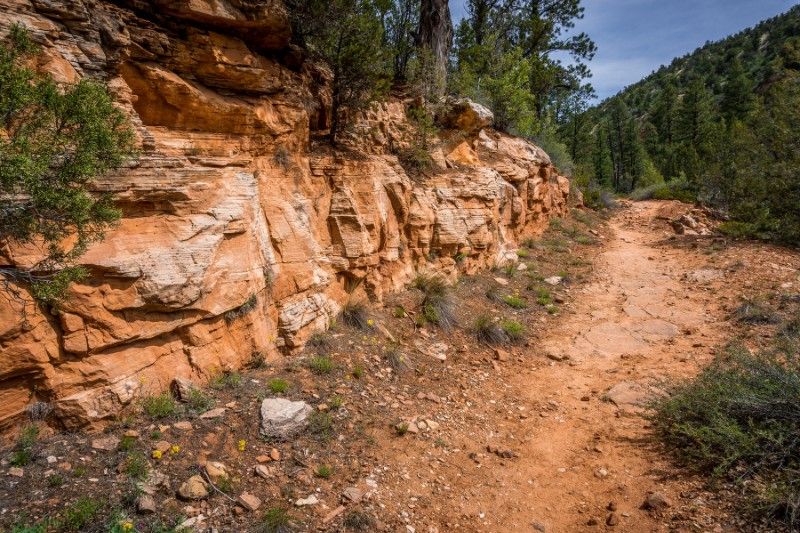
- Region: East Rim
- Trailhead: East Mesa
- Trail Difficulty: Moderate
- Trail Distance: 6.8 miles roundtrip
- Type of Trail: Out and back
- Elevation Gain: 300 ft
- Recent Comments: All Trails
East Mesa Trail is an easier and quieter way you can hike to Observation Point, rather than hiking the steep and busy trail from the main canyon. By hiking on the East Rim you’ll avoid crowds and elevation gain, but still enjoy the majestic canyon views afforded from Observation Point.
Hiking Tip: High clearance 4WD vehicles are highly recommended for reaching East Mesa Trailhead. Or Zion Ponderosa Ranch Resort offers a shuttle to the trailhead for $5 per person.
13. Many Pools Trail
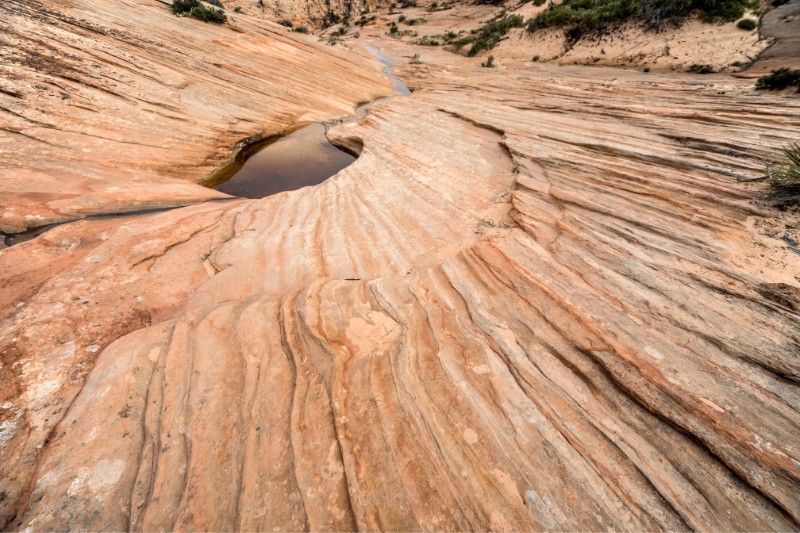
- Region: East Rim
- Trailhead: Zion-Mt Carmel Hwy
- Trail Difficulty: Moderate
- Trail Distance: 2 miles roundtrip
- Type of Trail: Out and back
- Elevation Gain: 500 ft
- Recent Comments: All Trails
Many Pools Trail is a hidden gem hike in Zion. Very few know it even exists, let alone hike it. The unmaintained trail is filled with smooth rounded pools and small waterfalls after rainfall. It’s a quiet and unique family friendly hike between east entrance and Zion-Mt Carmel tunnel.
14. Taylor Creek Trail (Middle Fork)
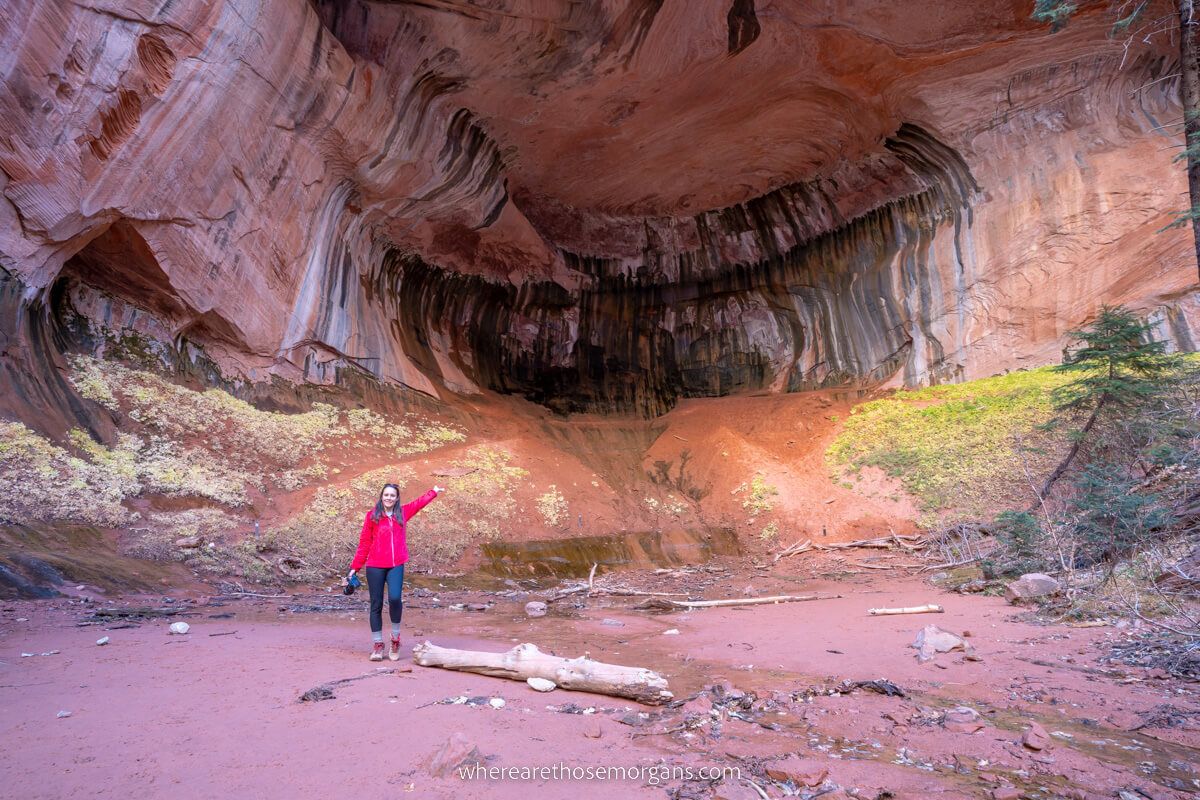
- Region: Kolob Canyons
- Trailhead: Taylor Creek
- Trail Difficulty: Moderate
- Trail Distance: 5.0 miles roundtrip
- Type of Trail: Out and back
- Elevation Gain: 450 ft
- Recent Comments: All Trails
Taylor Creek Trail is perfect for families or couples seeking a quieter Zion hiking experience. You’ll criss-cross the creek for 2.5 miles until reaching the impressive Double Arch Alcove. It’s a relaxing forest hike into a box canyon but it’s definitely engaging enough to keep your group entertained.
Further Reading: How to hike Taylor Creek Trail in Zion
15. South Fork Of Taylor Creek
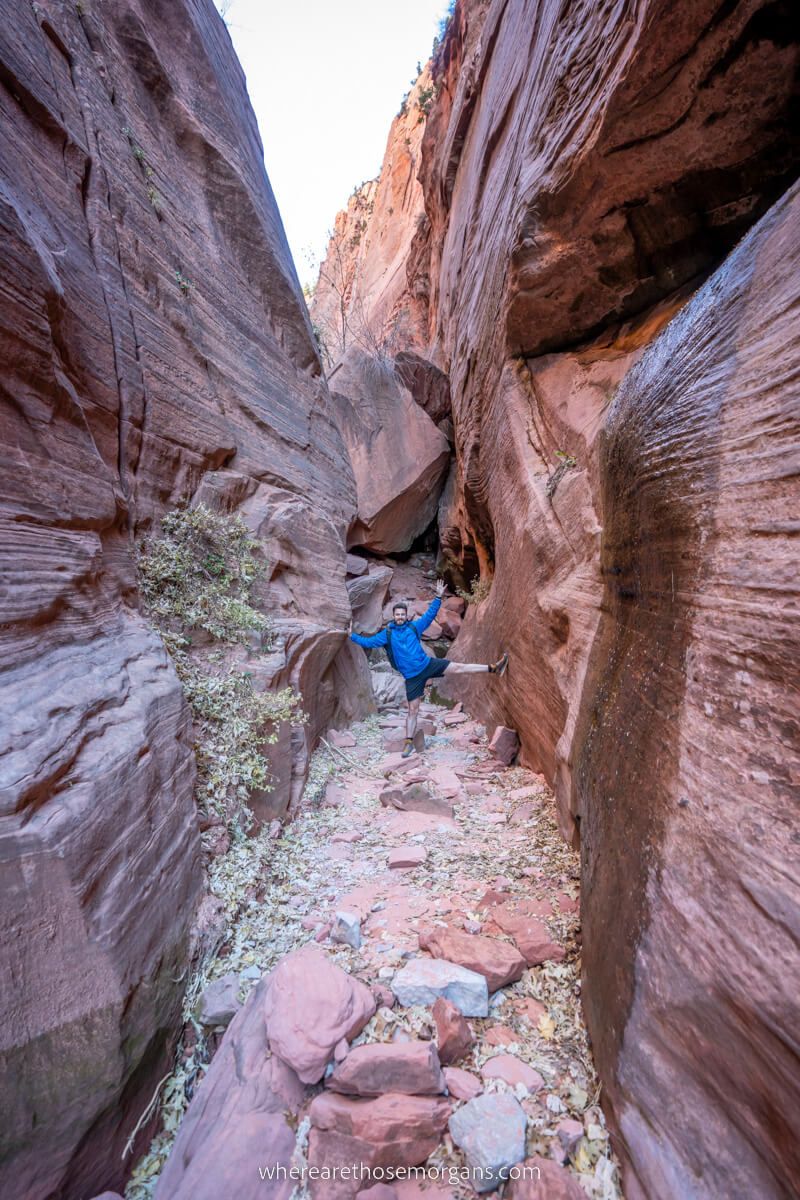
- Region: Kolob Canyons
- Trailhead: Unmarked parking lot on E Kolob Canyon Rd
- Trail Difficulty: Moderate
- Trail Distance: ~ 4 miles roundtrip
- Type of Trail: Out and back
- Elevation Gain: ~ 500 ft
- Recent Comments: All Trails
South Fork of Taylor Creek Trail is a true hidden gem hike in Zion National Park because you won’t find it on the map. Park at the second lot around 3 miles into E Kolob Canyon Rd and cross the road to pick up the fun trail, which leads to pink sand, towering cliffs and a V-shaped box canyon.
Further Reading: The best places to visit in Utah
Best Hard Hikes In Zion National Park
The hardest hikes in Zion should only be attempted by strong and experienced hikers because they’re challenging and dangerous. Our favorite is The Narrows, but we also love hiking Angels Landing and The Subway.
Below you’ll find the best hard difficult day hikes in Zion.
16. Angels Landing
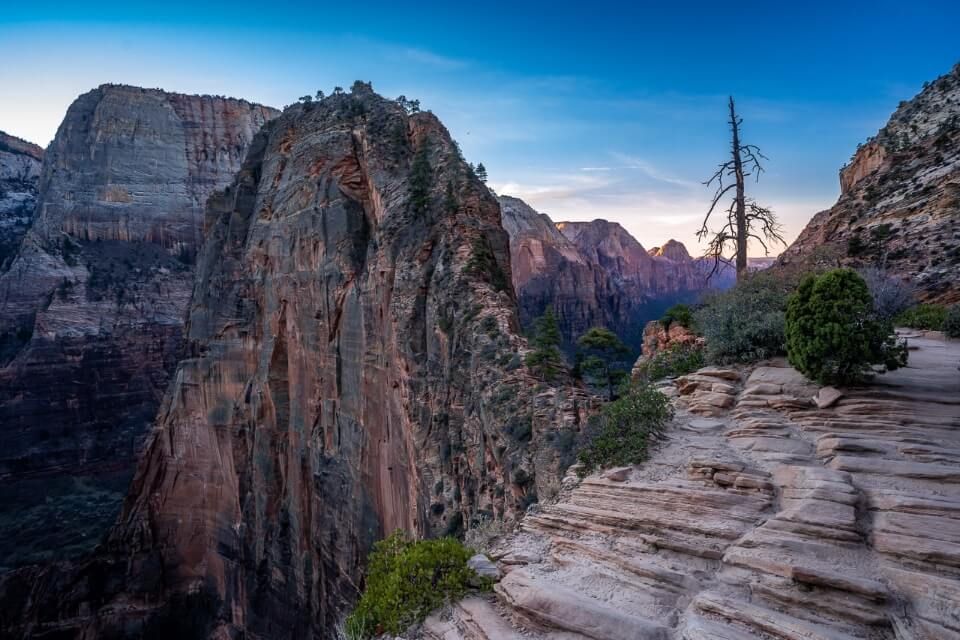
- Region: Main Canyon
- Trailhead: The Grotto (shuttle stop #6)
- Trail Difficulty: Strenuous
- Trail Distance: 5.4 miles roundtrip
- Type of Trail: Out and back
- Elevation Gain: 1,500 ft
- Recent Comments: All Trails
- Permits: NPS website
Angels Landing is unquestionably the most thrilling adventure hike in Zion National Park. The narrow chained sections will send your BPM into the stratosphere but it’s worth it for the experience and summit views. We’ve hiked Angels Landing twice, the second time we had the trail to ourselves at sunrise.
Further Reading: How to hike Angels Landing trail in Zion
17. Observation Point Via Weeping Rock
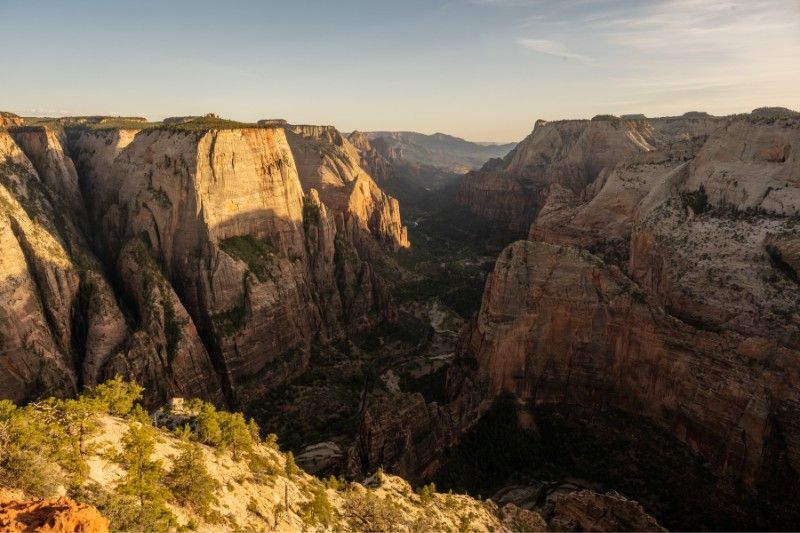
- Region: Main Canyon
- Trailhead: Weeping Rock (shuttle stop #7)
- Trail Difficulty: Strenuous
- Trail Distance: 8 miles roundtrip
- Type of Trail: Out and back
- Elevation Gain: 2,150 ft
- Recent Comments: All Trails
Observation Point via Weeping Rock is steep and challenging. You can hike an adventure spur trail into Hidden Canyon before summiting at the best viewpoint in Zion. But a landslide in 2019 caused the trailhead to close indefinitely, so the only way you can reach it is by hiking East Mesa Trail.
18. The Narrows
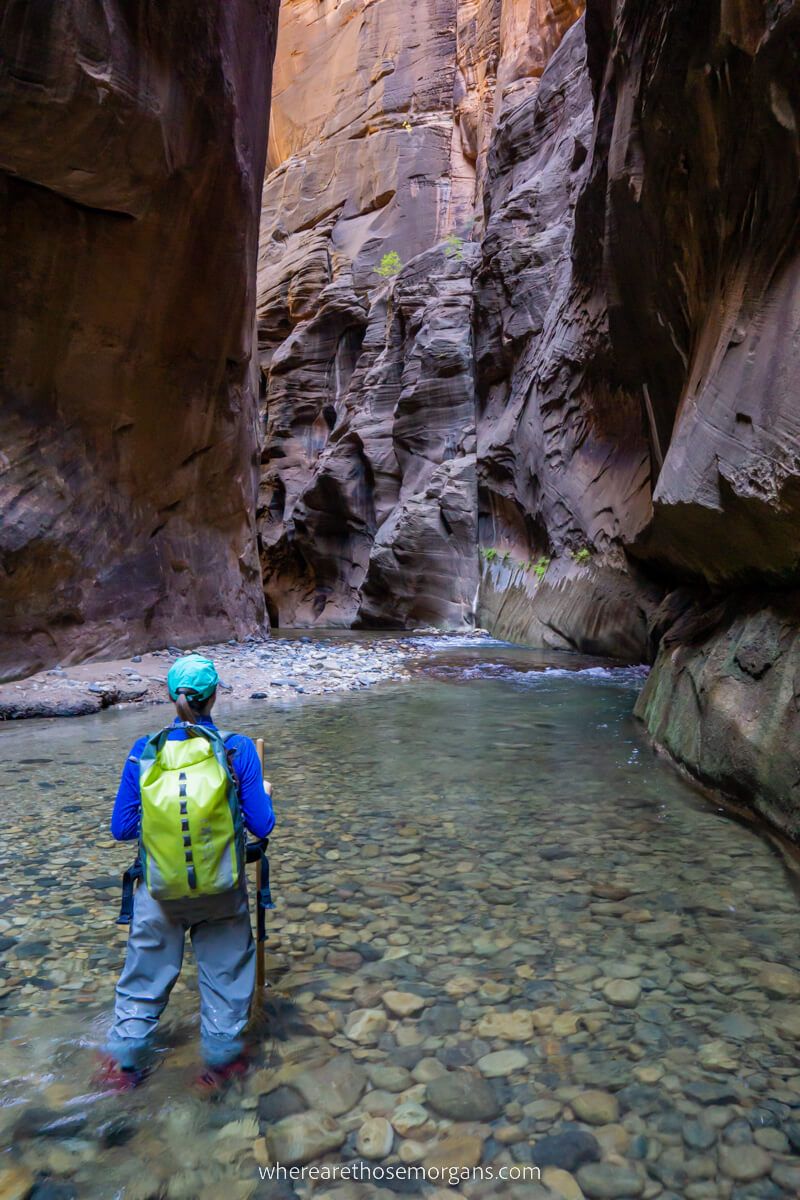
- Region: Main Canyon
- Trailhead: Temple of Sinawava (shuttle stop #9)
- Trail Difficulty: Strenuous
- Trail Distance: Up to 9.4 miles roundtrip
- Type of Trail: Out and back
- Elevation Gain: 350 ft
- Recent Comments: All Trails
- Top Down Permits: NPS website
The Narrows is an extraordinary adventure hike in Zion. You’ll slowly wade through a narrow river slot canyon in ankle, knee or waist deep water before turning around when you’re ready. Big Springs is the furthest you can go on a bottom up day hike, but it took us 8 hours to complete the whole thing.
Further Reading: Day hiking The Narrows bottom up
19. La Verkin Creek Trail
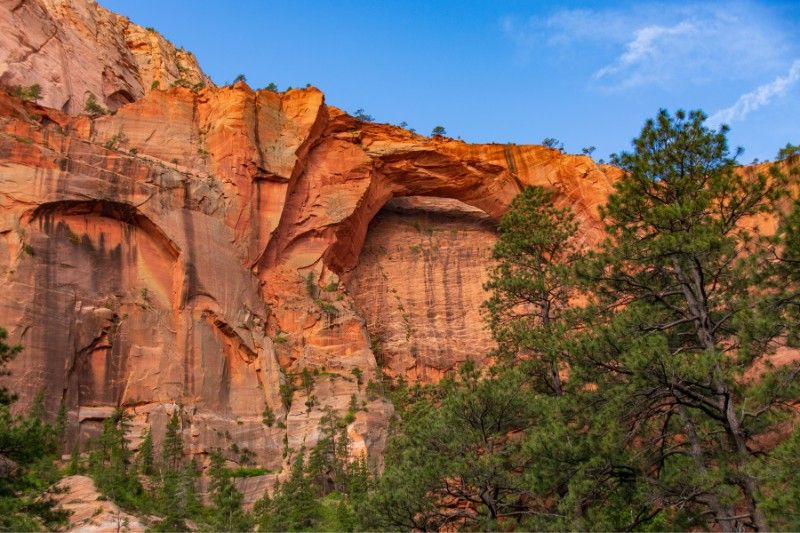
- Region: Kolob Canyons
- Trailhead: Lee Pass
- Trail Difficulty: Strenuous
- Trail Distance: 14 miles roundtrip
- Type of Trail: Out and back
- Elevation Gain: 1,100 ft
- Recent Comments: All Trails
La Verkin Creek Trail is the hardest hike in the Kolob Canyons region of Zion. You would barely see another soul on this long day hike and it ends at one of the world’s largest natural arches called Kolob Arch. This is the perfect trail for strong hikers who want to get off the beaten path.
20. The Subway
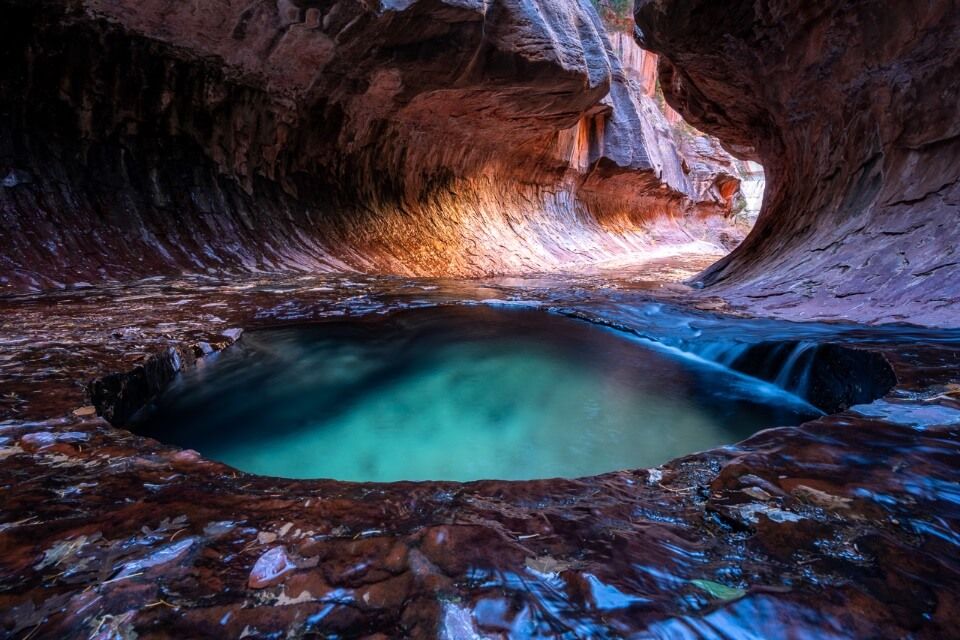
- Region: Kolob Terrace
- Trailhead: Left Fork
- Trail Difficulty: Strenuous
- Trail Distance: ~ 9 miles roundtrip
- Type of Trail: Out and back
- Elevation Gain: ~ 1,300 ft
- Recent Comments: All Trails
- Permits: NPS website
The Subway is an incredible adventure hike. You’ll forge your own path up Left Fork North Creek by crossing boulders, climbing steep banks and wading through water until you reach The Subway tunnel formation. Daily hiker numbers are limited so you get a real lost world feel. It’s one of our favorites.
Further Reading: Day hiking Zion The Subway bottom up
Wilderness Hikes In Zion National Park
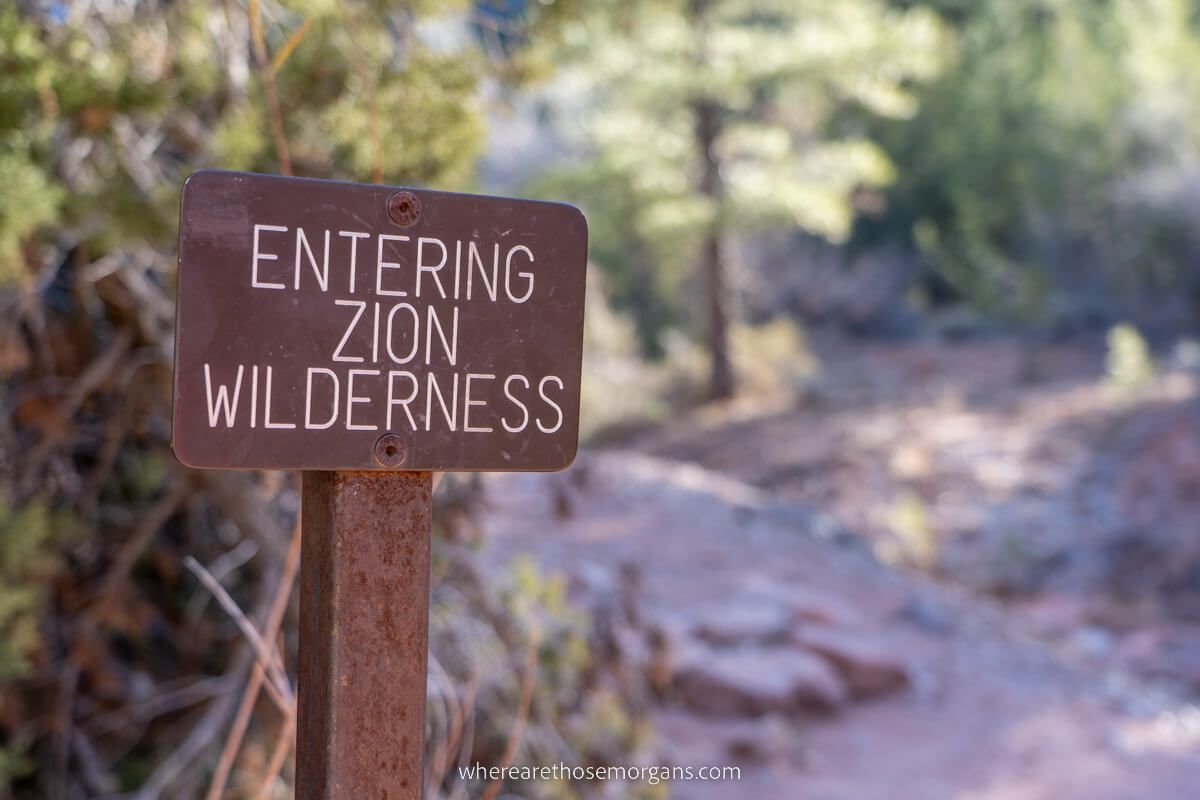
You should consider hiking some of Zion’s wilderness trails if you’re a strong hiker, it’s your third or fourth visit or you want to ditch the crowds. You’ll need permits for backpacking camping.
Here are 3 top rated wilderness trails in Zion that we would prioritize:
1. East Rim Trail – Trailheads located at East Entrance to Zion and Zion Pines Cabin. Leads to Observation Point, Deertrap Mountain and Cable Mountain.
2. West Rim Trail – Can be hiked bottom up or the more popular top down version. Begin at the trailhead near Lava Point off Kolob Terrace Rd, before camping overnight and descending into the main canyon via Angels Landing.
3. Chinle Trail – Begin at the trailhead on Anasazi Way in Rockville, hike low desert to Coalpits Wash and continue to the campsite before looping on Scoggins Wash and finishing at Coalpits Wash trailhead in Grafton.
Need a campsite in Zion? Take advantage of our exclusive 30 day free trial of The Dyrt PRO to get reservations at sold out campgrounds like Watchman and South in Zion. Try it for free today with no strings attached!
Zion National Park Hiking Itinerary Ideas
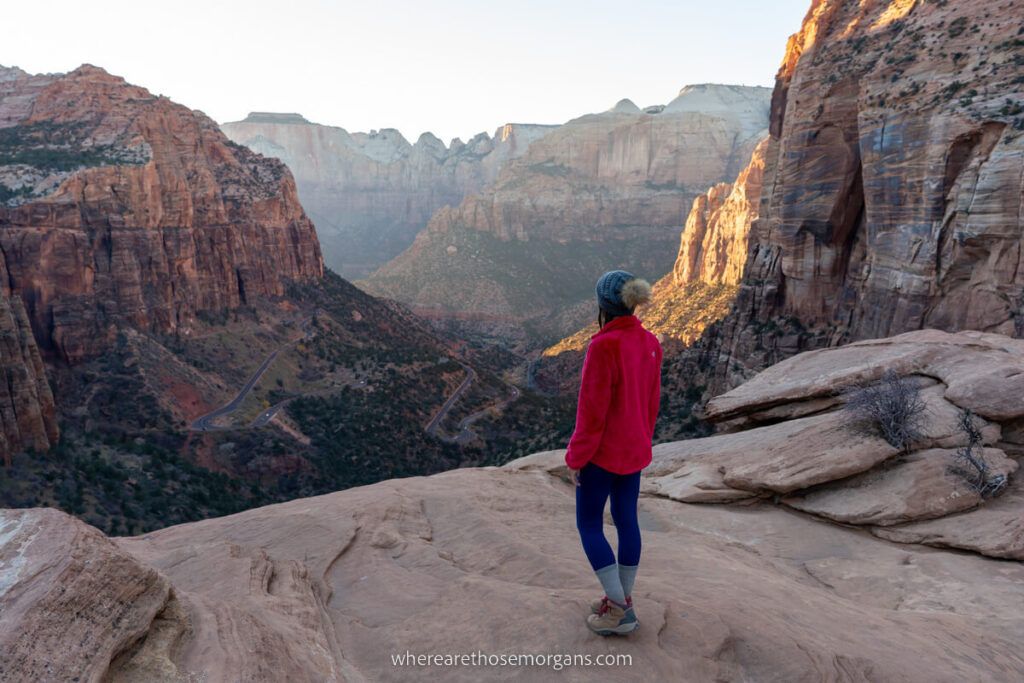
You know the best easy, moderate and hard trails in each of the 5 regions in Zion. But how do you piece the hikes together into an efficient itinerary for your visit?
Here’s how we would plan one, two and three day Zion hiking itineraries with the knowledge we’ve gained after 6 full days on the trails.
Easy One Day Itinerary
Morning – Start at Zion Lodge and take The Grotto Trail to The Grotto Picnic Area. Cross the bridge and turn left onto Kayenta Trail, before taking a left at the fork and passing underneath Lower Emerald Pool waterfall. Grab lunch in Springdale.
Afternoon – Drive to Kolob Canyons and hike the short Timber Creek Overlook Trail for huge views. Head back to Springdale and drive up through the tunnel so you can hike Zion Canyon Overlook Trail in time for sunset.
Challenging One Day Itinerary
Morning – Hop on the first canyon shuttle of the day to stop #6 The Grotto. Hike to Angels Landing and arrive as close to sunrise as possible (you’ll need a permit). Once back down, hike Kayenta Trail to Emerald Pools Trail and see all three pools. Head back to Springdale for a quick bite to eat and pick up waterproofs with a wooden pole.
Afternoon – Take a shuttle to stop #9 Temple of Sinawava. Hike Riverside Walk and head into The Narrows for as long as you feel comfortable. If you have enough time once you’re back in Springdale, drive up to hike Zion Canyon Overlook for sunset.
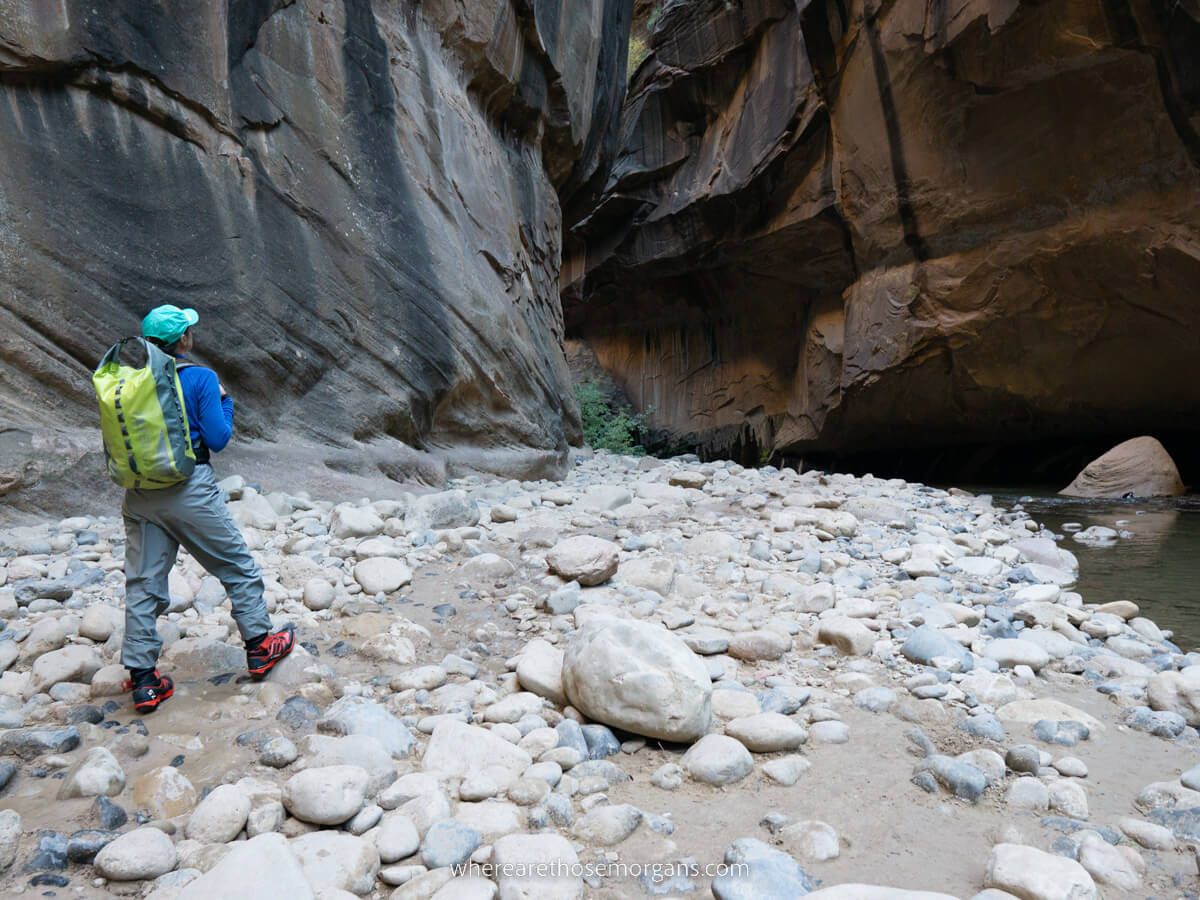
Adventurous Two Day Itinerary
Day 1 – Get an early start and spend the whole day hiking The Narrows bottom up as far as Big Springs. You’ll need a packed lunch and plenty of water. Hike The Watchman for sunset if you’re back in Springdale in good time.
Day 2 – Hike Angels Landing at sunrise (with permit), then take Kayenta Trail to see all three Emerald Pools. Drive up to East Rim and hike East Mesa Trail to Observation Point. Stop at Zion Canyon Overlook trail for sunset on the way back to Springdale.
Balanced Three Day Itinerary
Day 1 – Start early and hike The Narrows for a few hours but don’t go all the way to Big Springs. Head back to Springdale to return your waterproofs and walking pole. Grab an early lunch before driving over to Kolob Canyons. Hike Taylor Creek Trail (Middle Fork) and then walk out to Timber Creek Overlook. If you have time and energy, hike up to The Watchman summit before sunset.
Day 2 – Hike Angels Landing with the pre-9:00am permit because it will be quieter. Take Kayenta Trail to see the three Emerald Pools. Head up to East Rim to hike East Mesa Trail so you can see the impressive views from Observation Point. Stop at Many Pools and finish with Canyon Overlook Trail for sunset.
Day 3 – Spend the whole day hiking The Subway bottom up (with permit). You’ll need a packed lunch and lots of water. We highly recommend tracking your hike with an offline maps app.
Further Reading: Zion National Park day trip itinerary ideas
Zion Hiking Permits
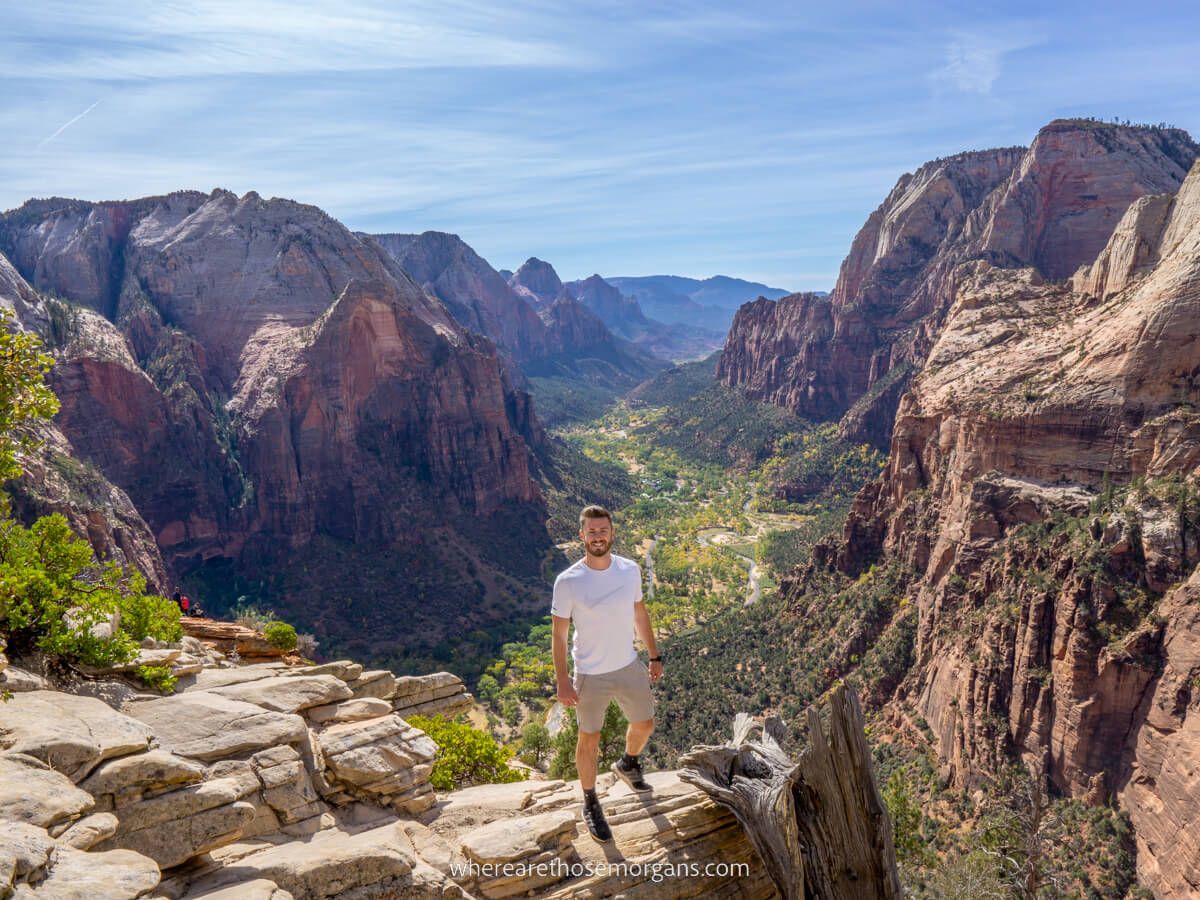
You’ll need hiking permits for 3 trails in Zion National Park:
- Angels Landing
- The Narrows
- The Subway
Angels Landing – You must obtain this permit to hike Angels Landing. There are 3 daily time slots available: before 9:00am; from 9:00am to 12:00pm and after 12:00pm. You can hike to Scout Lookout without a permit but you won’t be allowed on the chain sections.
The Narrows – Almost all visitors to Zion day hike The Narrows bottom up and you won’t need a permit for this version. But you must obtain this permit if you are hiking the top down version.
The Subway – You must obtain this permit to hike both the top down and bottom up version of The Subway.
Hiking Angels Landing And The Narrows In One Day
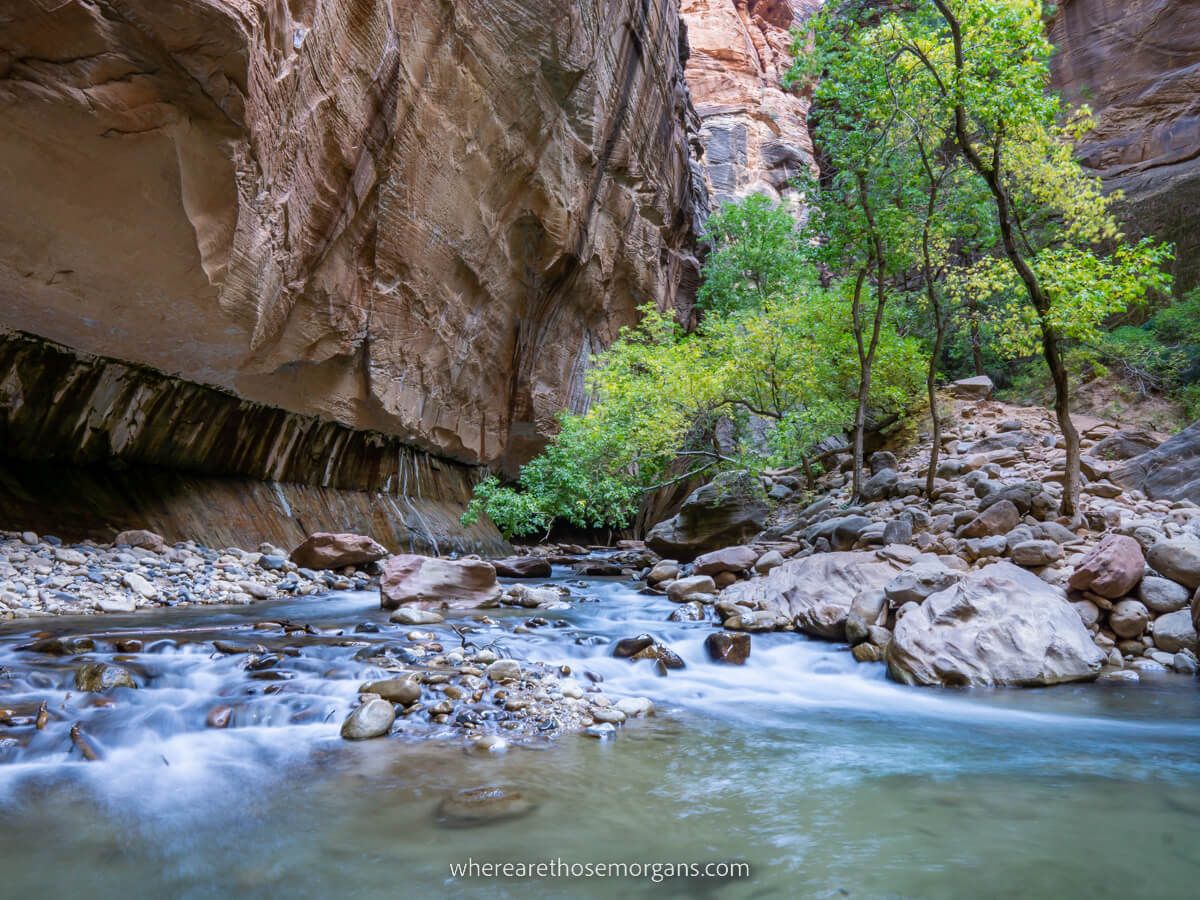
It’s possible for strong and experienced hikers to complete both Angels Landing and The Narrows in one day. You’ll need to buy a before 9:00am permit to hike Angels Landing and begin before first light. Aim to reach Scout Lookout as daylight breaks so you can see clearly on the climb to Angels Landing.
Afterwards, head back to Springdale so you can pick up waterproofs and a walking pole, you’ll need both if you want to reach Big Springs. As long as you begin The Narrows by 10:00am, you should be able to make it to Big Springs and back by sundown, but it gets dark quickly inside the narrow slot canyon.
You must carry at least 2 fully charged headlamps for the climb to Angels Landing and the last hour or two inside The Narrows. If sunset is at 6:00pm, you should turn back in The Narrows at 2:00pm even if you haven’t made it all the way to Big Springs.
Further Reading: The 25 best hikes in Utah
Best Time To Hike In Zion
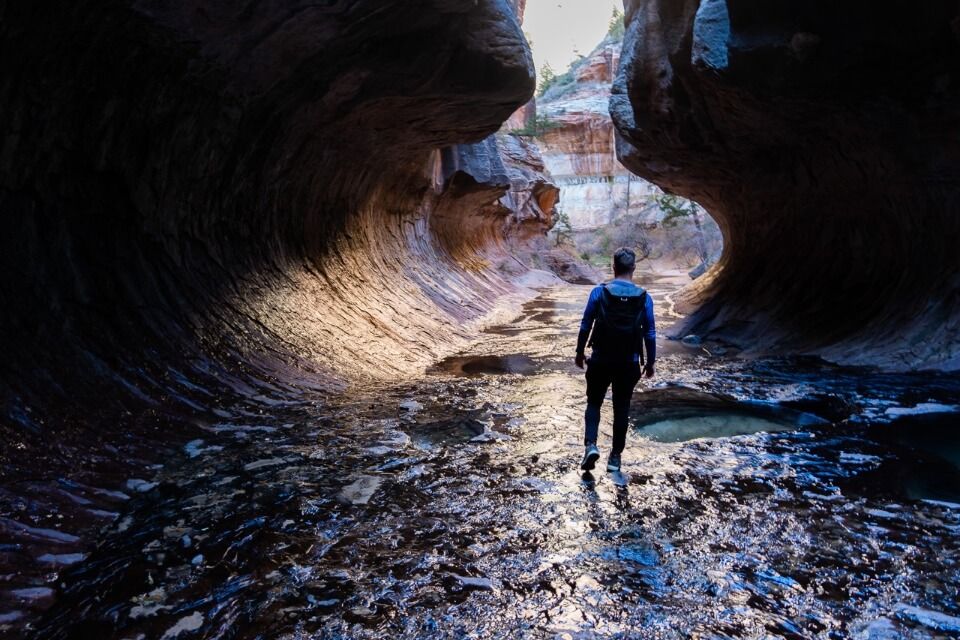
The fall months of September, October and November are the best time to hike in Zion because you’ll benefit from fewer crowds, cheaper hotel rooms, comfortable hiking temperatures, lower water levels in The Narrows and The Subway, and stunning Autumnal colors in the canyons.
It’s also quiet and comfortable in spring but Zion is prone to flash flooding. You’ll get warmer weather and longer days in summer, but it’s also excessively overcrowded and overpriced at hotels. The quieter trails in winter are offset by freezing cold temperatures in the mornings and evenings.
We’ve visited Zion in October and December. We were able to hike The Narrows comfortably in October but the park was packed full, so we actually preferred our trip to Zion in winter because we had most trails completely to ourselves, including Angels Landing at sunrise which was amazing.
Further Reading: The best time to visit Zion National Park
Zion Hiking Tips
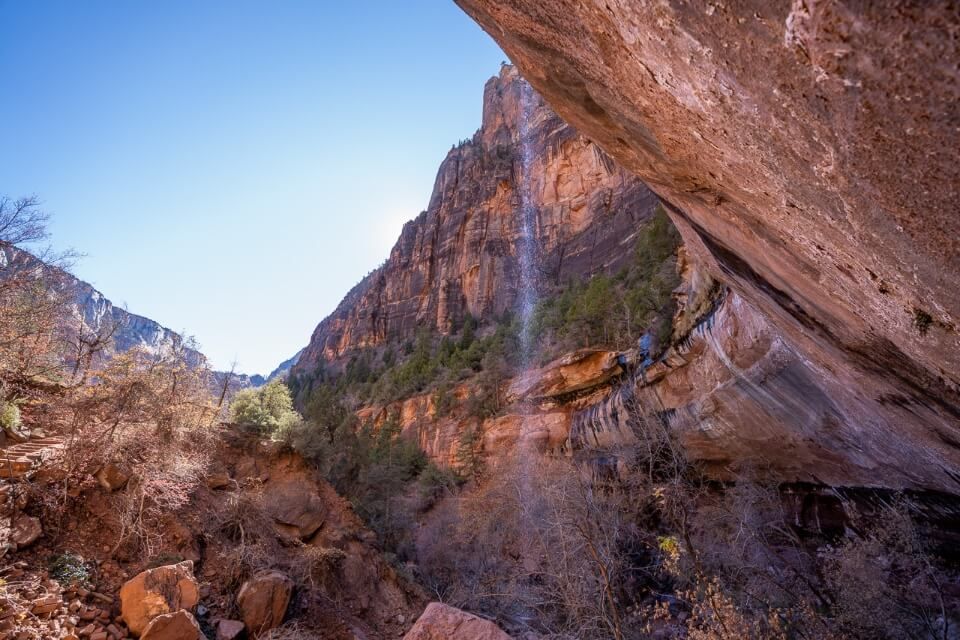
Here are some of our top tips for hiking in Zion National Park:
- Check live conditions in Zion before visiting
- Apply for hiking permits months in advance
- Peak season lasts from May until September
- Visit in the off season to win next day permits
- Springdale is the most convenient place to stay
- It’s much quieter and cheaper in winter
- You can use your America the Beautiful Pass
- Watch for flash flooding in spring
- Kolob Canyons is a quieter hiking alternative
- Hire waterproof gear the night before hiking The Narrows
- You must use the Zion shuttle in the main canyon during peak season
- Always pack plenty of fluids when hiking in warmer months
Top Hiking Tip: Zion is one of the top vacations spots in the USA so you need advanced hotel reservations, hiking permit reservations and even restaurant reservations in peak season.
Hiking Apps
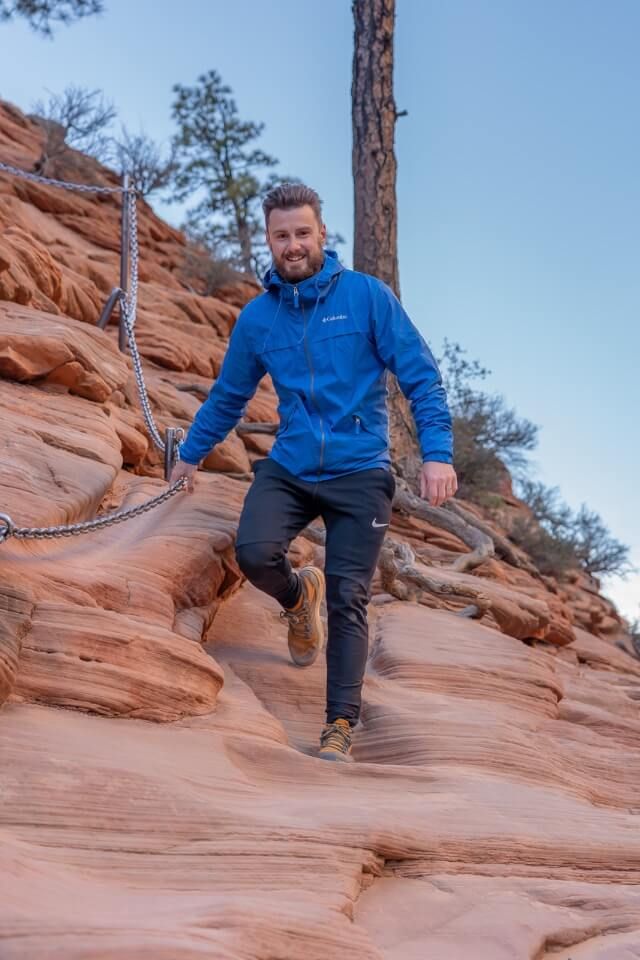
Do you use any of the best hiking apps to download trail maps so you can track your live location throughout your hike, even when you’re offline?
We use All Trails to read recent comments before hiking a new trail, but we use Gaia GPS Premium to download offline maps and track our hikes. In Zion, you can use offline maps to make sure you’re on the right paths and we have an exclusive 20% discount link for our readers to use with Gaia GPS.
Further Reading: The 20 best US national parks
In Conclusion
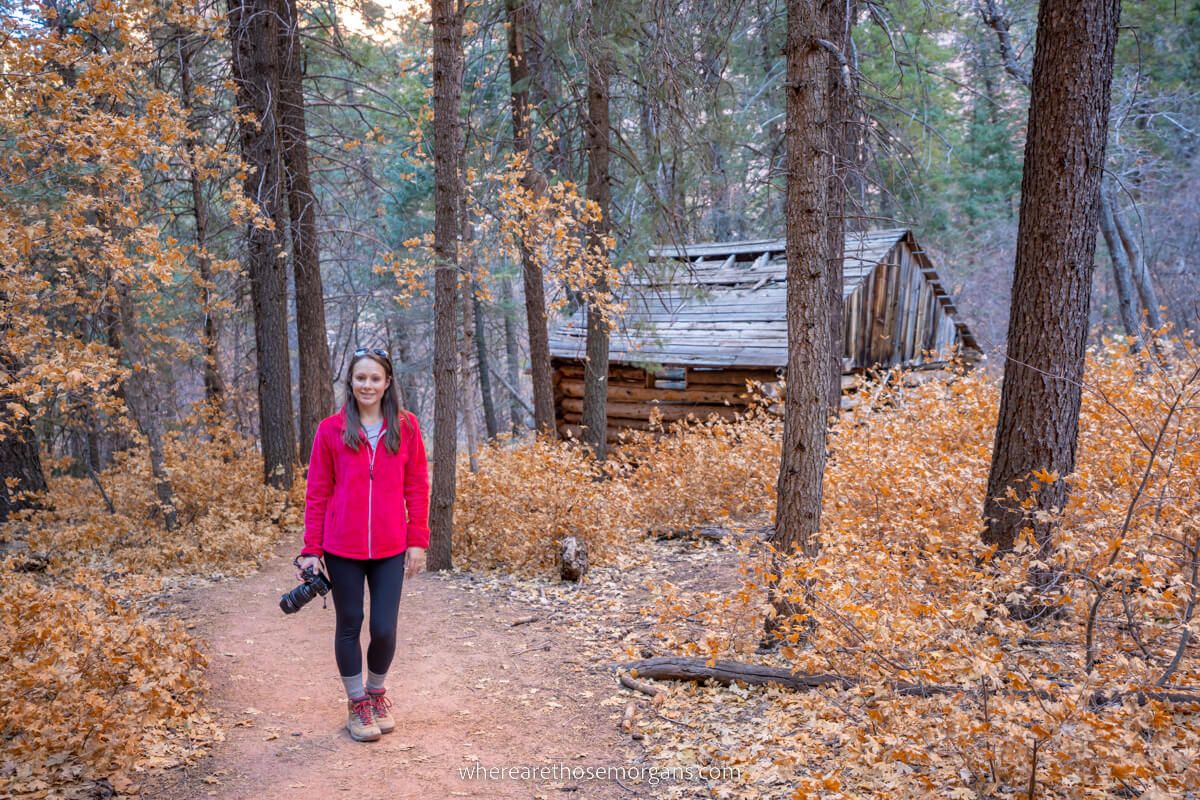
There are lots of fun hikes to choose between in Zion. Angels Landing, The Watchman and Emerald Pools are the three best hikes in Zion according to All Trails. But we personally think The Narrows, Angels Landing and The Subway are the top 3 trails to try if it’s your first visit to Zion and you’re a strong hiker.
We’ve hiked in most of the popular US national parks and Zion is right up there as one of our absolute favorites. We were blown away by the uniqueness of Angels Landing and The Narrows in particular. It’s definitely a one-of-a-kind place to lace up and hit the trails!
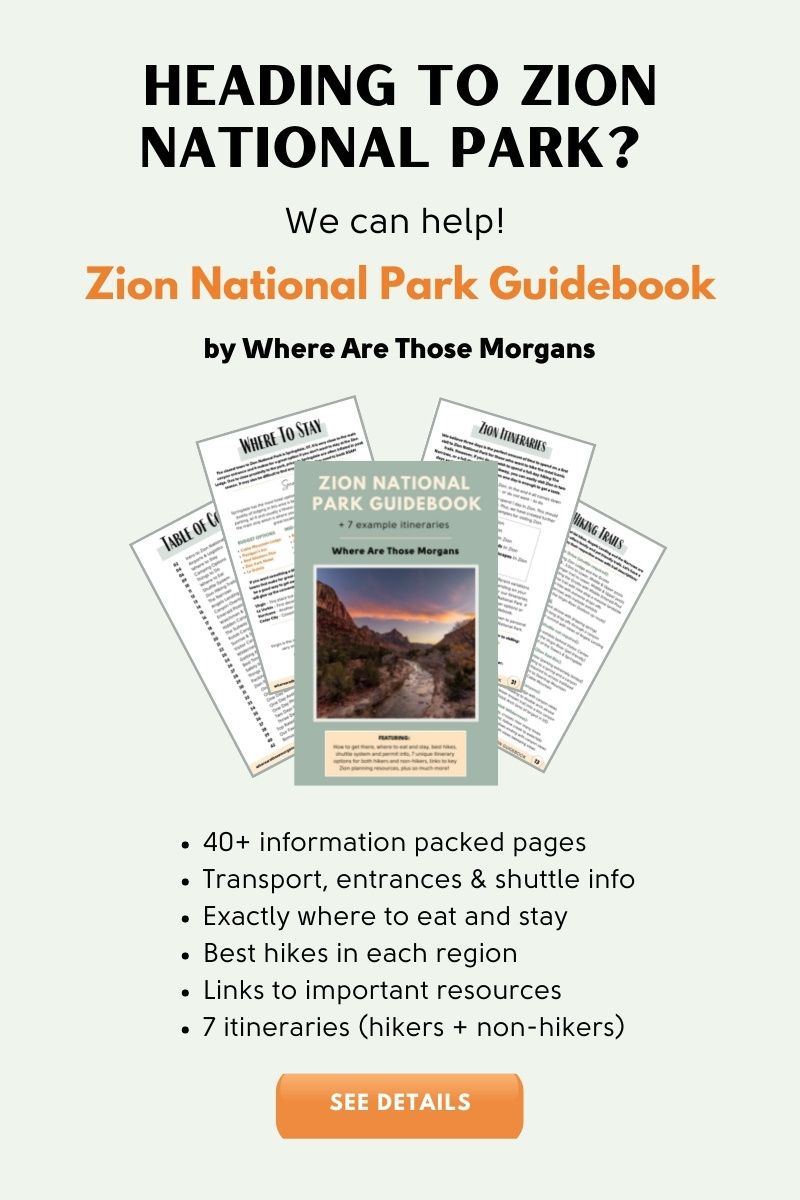
More From Zion
- Best time to visit Zion National Park
- Closest airports to Zion National Park
- Key things to know about Zion in winter
- One day Zion National Park itinerary ideas
- The best Utah road trip itineraries
- Where to stay near Zion National Park
- Zion to Bryce Canyon 3 day road trip
More US Hikes
- 3 best hikes in Arches National Park
- 7 best hikes in Badlands National Park
- 10 best hikes in Acadia National Park
- 10 best hikes in Red Rock Canyon
- 17 best hikes in Grand Canyon South Rim
- 20 best hikes in Sedona Arizona
- 23 best hikes in Mt Rainier
Want more Utah content? Head over to our Utah Travel Guides to explore the Mighty Five National Parks and beyond.
We hope this guide to the best hikes in Zion National Park helps with planning your Zion hiking itinerary!
Please let us know if you have any questions about hiking in Zion or you need help planning your trip in the comments below.
Happy Hiking,
Mark and Kristen
Find this Zion hiking guide helpful? Pin it for your visit!
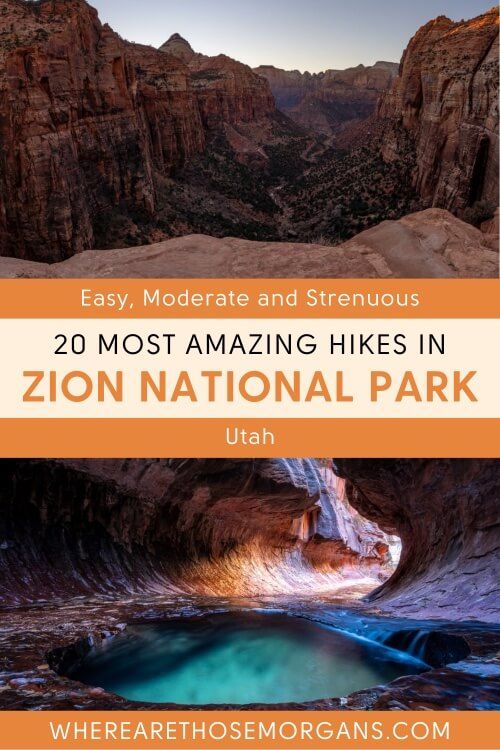
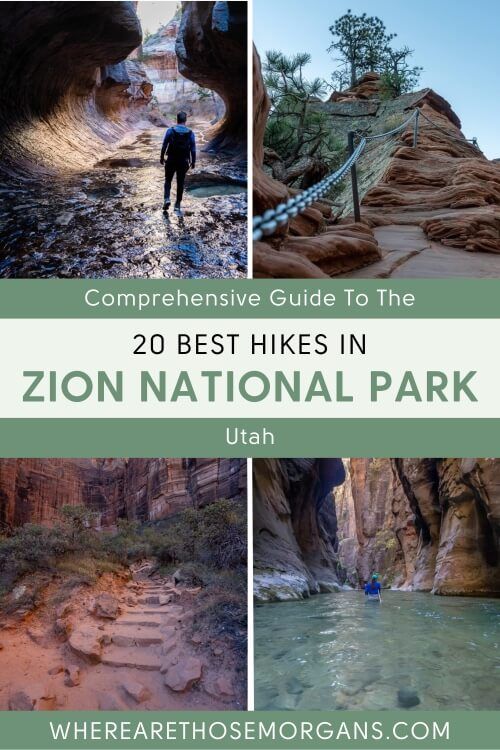
Note: This article contains affiliate links. When you make a purchase using one of these affiliate links, we may earn a small commission at no extra cost to you.
All Rights Reserved © Where Are Those Morgans, LLC. Republishing this article and/or any of its contents (text, photography, maps, graphics, etc.) in whole or in part is strictly prohibited.
Mark and Kristen Morgan are travel, hiking and photography experts. Over the last 6 years traveling full time, they have explored more than 40 countries and 30 US states.
Where Are Those Morgans has been featured in USA Today, Gestalten, Get Your Guide, CityPASS and Condé Nast Traveler along with various other publications. Read more about us.

